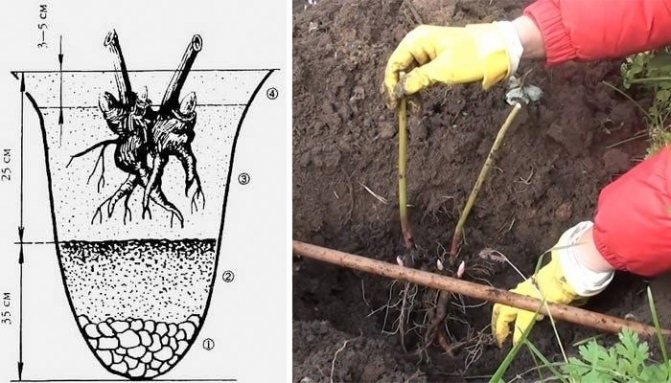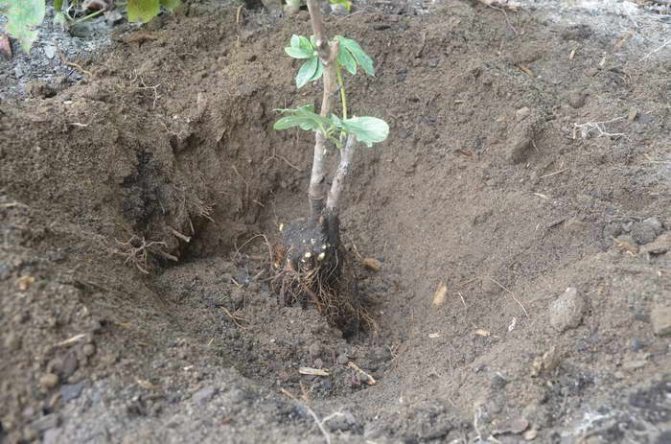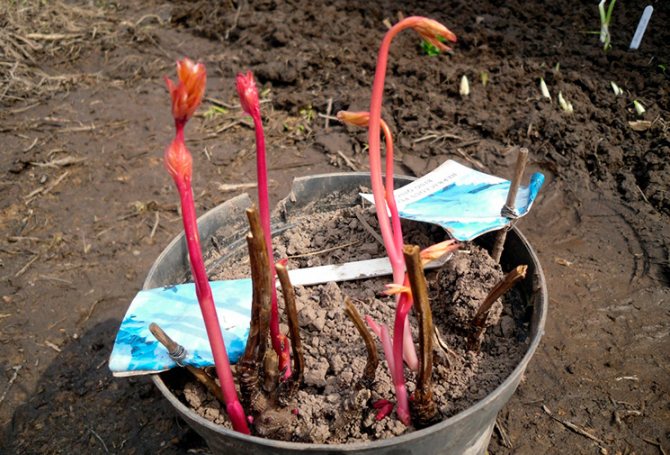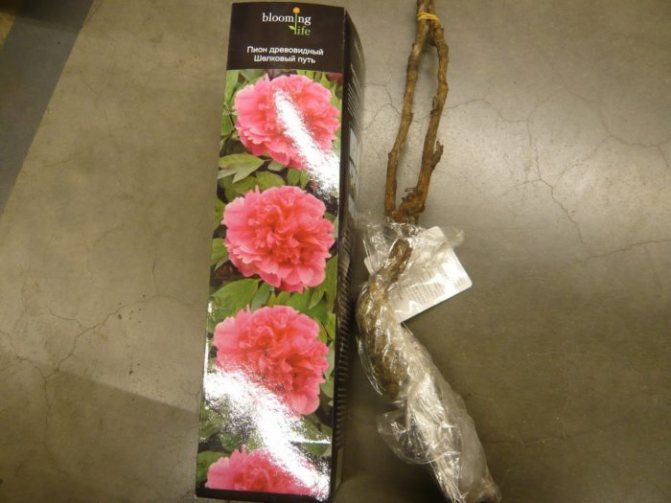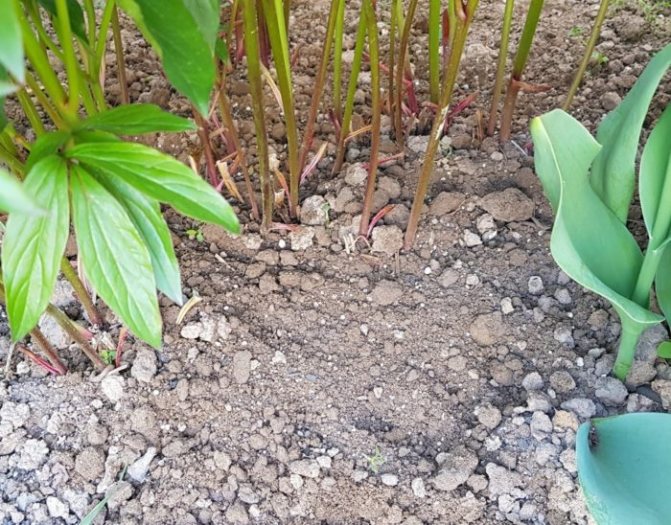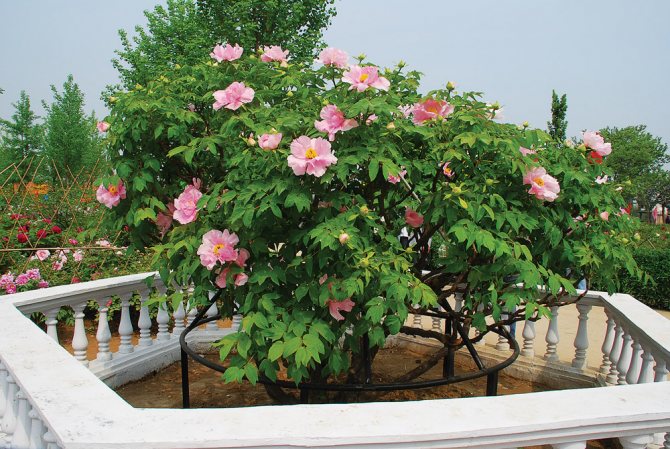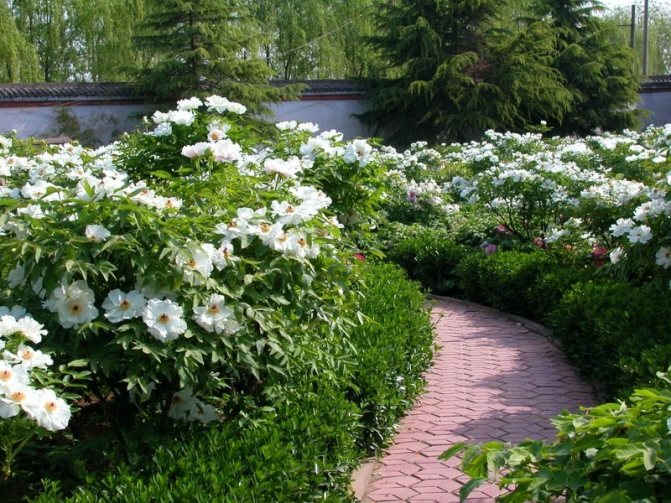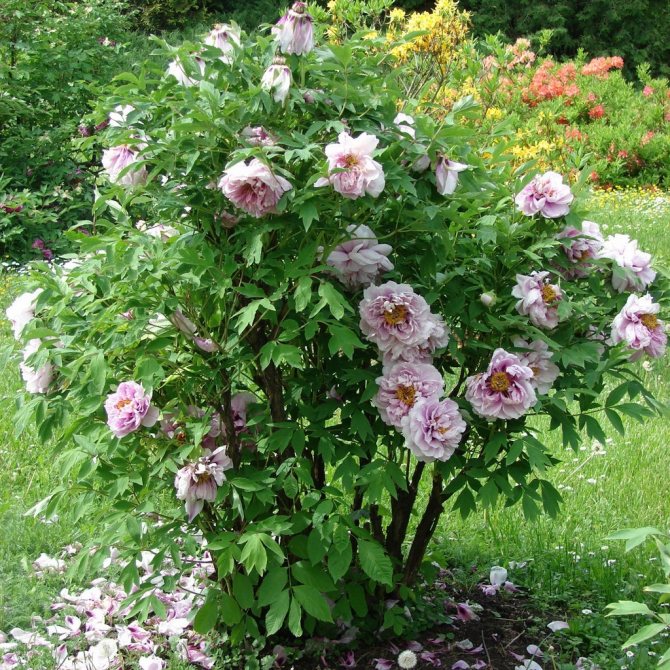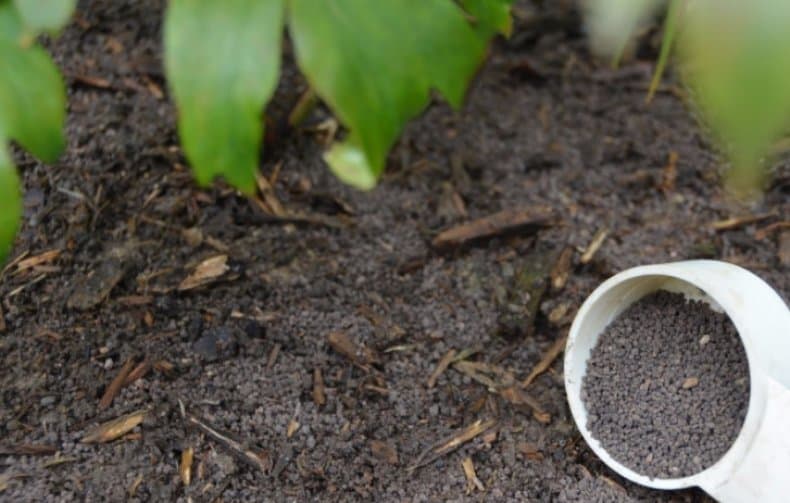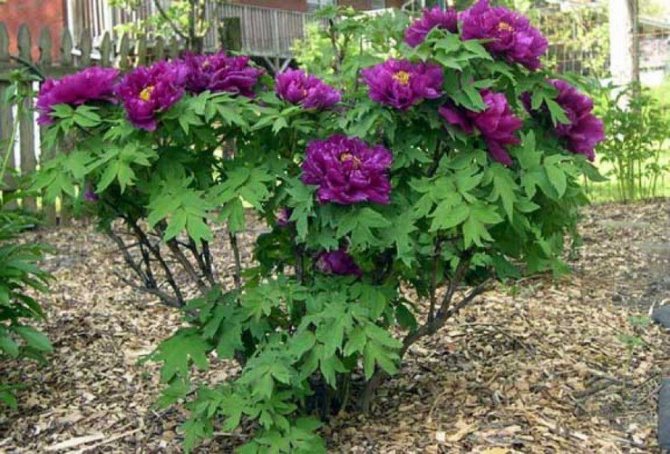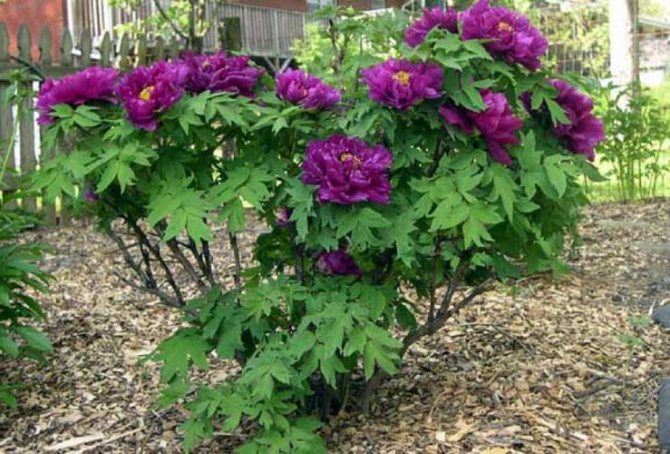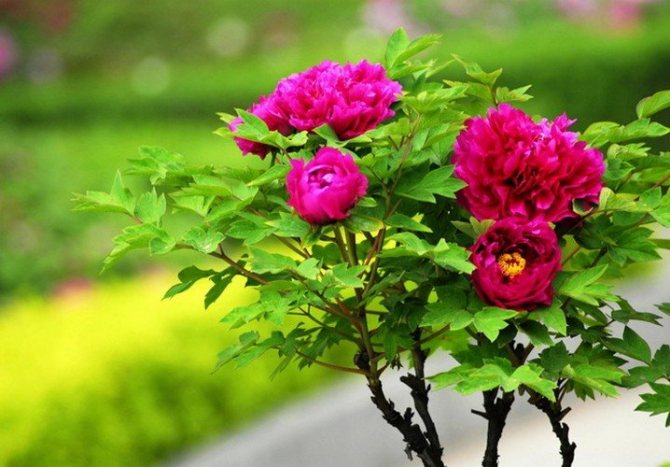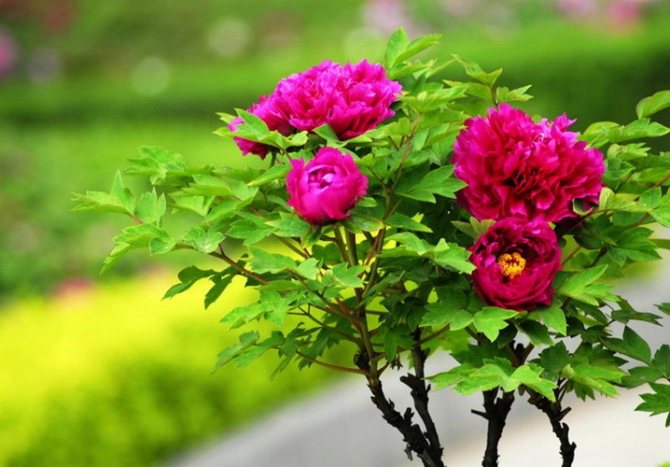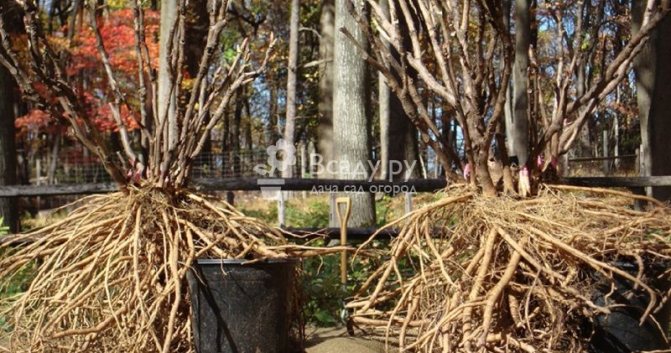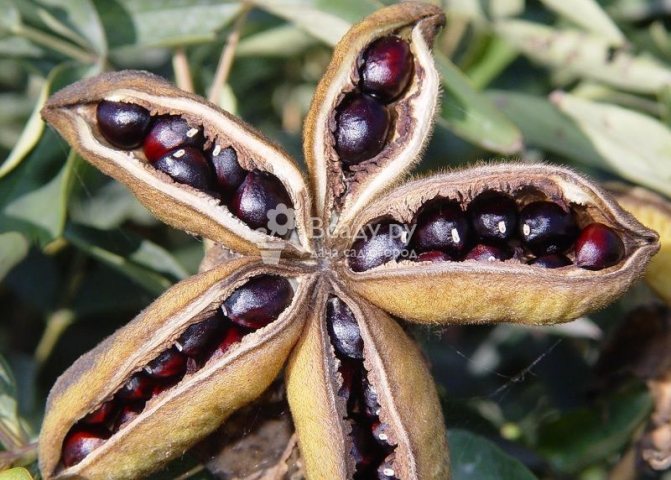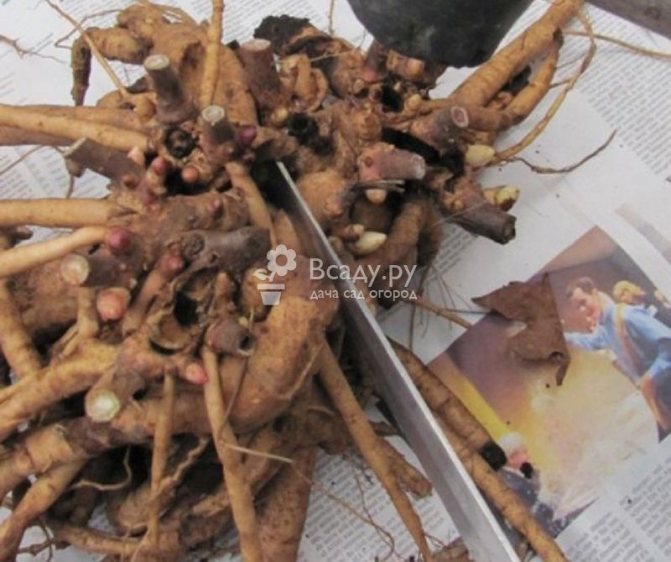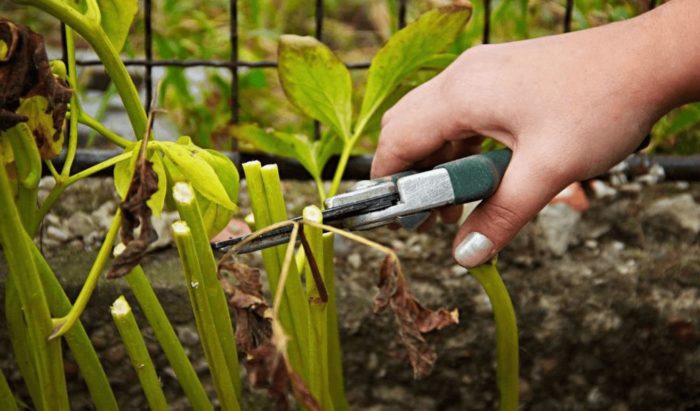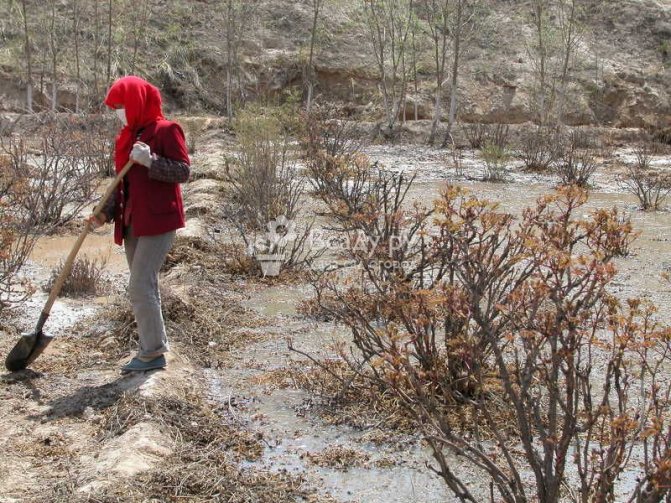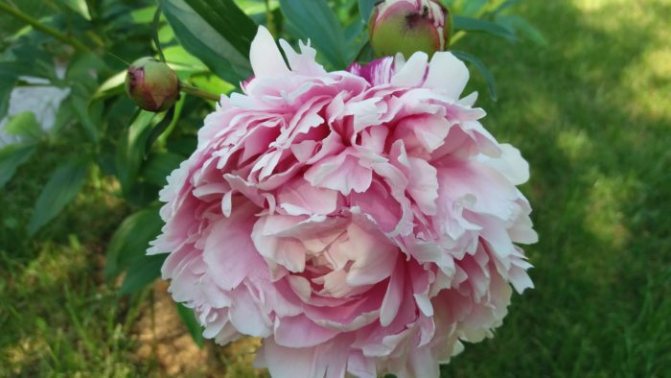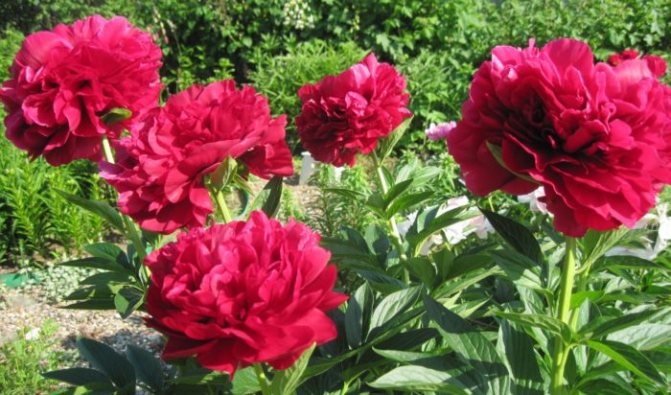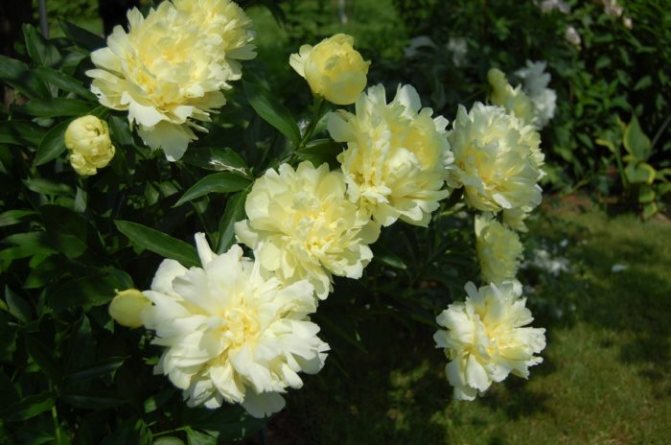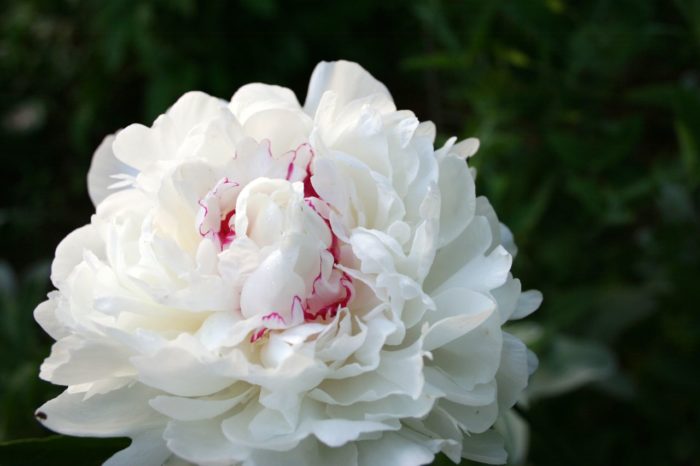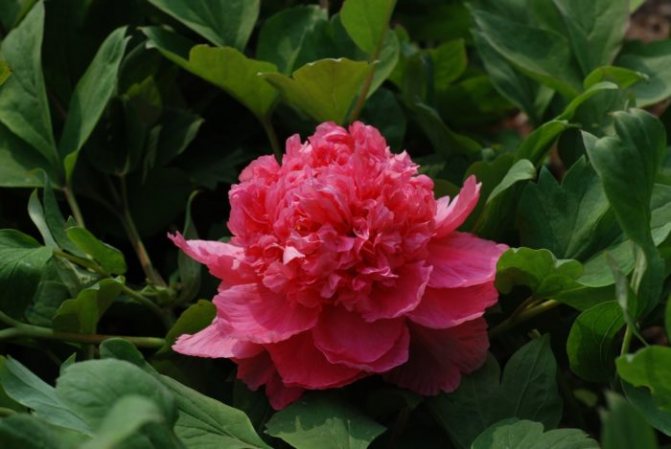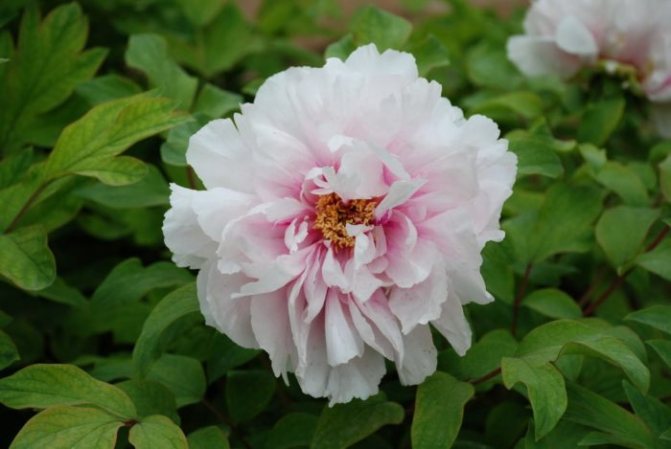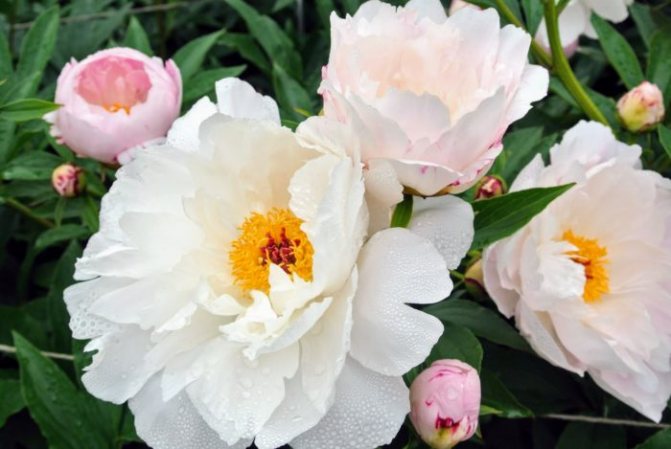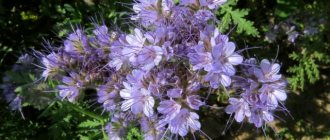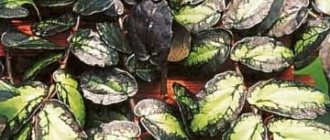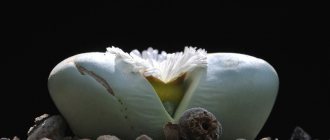The tree peony is a species of hybrid plants of the Peony family. Currently, Chinese breeders have bred almost 500 species of this plant. In Japan, the tree peony began to grow during the Tang Dynasty. In the 18th century, the plants were brought to Europe, where they were enthusiastically received by professional flower growers and amateurs. What care does this plant require, how to cover a tree-like peony for the winter, can it survive frosts? Let's try to answer these questions, which are often asked by novice growers.
How to choose seedlings for planting
For a plant to be healthy and produce a large number of beautiful flowers, you need to choose the right seedlings and the time for planting. Peony planting material is different: with an open root system or closed. If the seedling is packed in a beautiful box, a plastic bag, and the roots are bare or in the substrate, this is an open root system. When closed, the peony is placed in a flower pot, grows there, sometimes already with buds.
Another important point is whether the seedling is grafted or self-rooted. In a grafted plant, the roots are darker and thicker, reach a diameter of 5 cm, outwardly resemble a carrot. Flowering can occur as early as the first year after transplanting. It is better to buy grafted tree peony seedlings in nurseries, where they were looked after by professional workers.
Own-rooted seedling, obtained by propagation by layering, has several thin light roots. You will be able to see the first flowers not earlier than in four years, because the growth is slow. Layers are obtained as follows: a healthy branch of a bush with buds is bent over and sprinkled with earth. Roots sprout in places of budding. Later, the branch is cut and divided into several seedlings with roots. When buying, pay attention that the roots are not exposed. The shoot height should be 20-25 cm and the presence of live buds should be at least 5 pieces.
Growing conditions
Peonies are considered light-loving plants, it is because of this that a sunny area will be required for harmonious growth, best of all - on a small elevation. Plants do not tolerate a transplantso the landing site must be constant. It is better if there are no other large plants around, such as shrubs or trees.
Growing a tree peony will require early preparation of the site and soil. Flooded areas with excessive moisture are not suitable for the growth of a tree peony. If there is no alternative, it will be necessary to install drainage and ensure the removal of excess moisture. Give preference to soils with an alkaline reaction (pH 7.5 to 8).
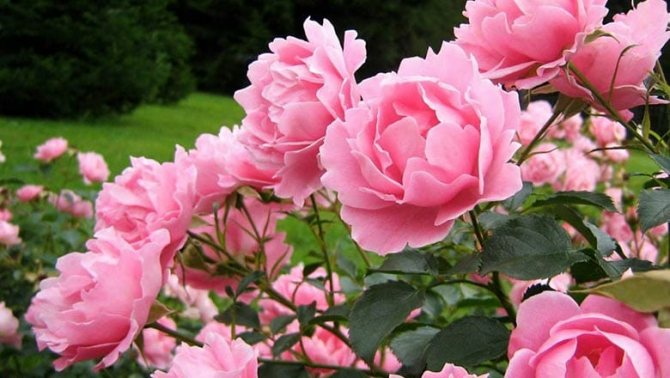
Rules for planting a tree peony
A lot depends on compliance with the landing rules. Sometimes the tree-like peony is well received, has lush greenery, but does not bloom. This indicates that there was a violation of one of the rules during landing. If you want to have an amazing bush with lushly blooming peonies on your site, listen to the advice of specialists who know how to properly plant an ornamental plant.
The location of the peony in the garden
Start by choosing the right landing site. Peonies love the sun.Choose a place for them in a flowerbed or plant them along the paths, taking into account that in a few years they will grow much in size. Peonies do not tolerate crowding, they are painful for a small space. A bush planted near the wall of the house may die. If you protect the tree peony from wind and drafts, it will repay you with large bright flowers.
Preparing the soil and planting pit
A good drainage from rubble and sand should be arranged at the planting site. The root system does not tolerate stagnant water. It is better to make a dug hole for planting with a size of 70x70 cm, so as not to damage the roots. The depth is done with the expectation that the grafting site (neck) or the lowest bud should be 10-15 cm in the ground. Put humus at the bottom of the pit, complex fertilizer and 1 tablespoon of copper sulfate in the middle layers of the earth to destroy harmful microorganisms. A small amount of slaked lime mixed with the ground will not hurt, which reduces the acidity of the soil.
The best time to disembark
The most favorable time for planting a tree peony is the end of August or September. In China, in the homeland of the plant, a special day has been established for planting or transplanting the imperial flower - the day of the autumn equinox (September 22-23) with a deviation of one day in one direction or another. Spring planting negatively affects the seedling, because it is time for active growth and flowering, and the peony painfully tolerates adaptation.
If the seedling came to you at the end of winter, in the spring, preserve it until the end of summer. Plant in a small container of earth and leave in a cool, lit place. During these months, the root system will strengthen; in August-September, plant it in a permanent place that you have chosen in advance. Fulfilling all the planting conditions correctly, you will become the owner of a gorgeous imperial plant.
Own-rooted and grafted tree peonies
Tree-like peonies can be self-rooted and grafted. Both have their own advantages and features that must be taken into account when growing. In some areas, the requirements for care differ.
| Own-rooted tree peonies in suitable conditions they will live for a very long time, more than 20 years (theoretically up to 200 years). They are very viable, winter well, and disease resistant. Own-rooted peonies are easy to propagate by dividing the bush. An inconvenience is that such peonies bloom only 4-5 years after planting and grow slowly during the first five years. By this age, they reach a height of 60-70 cm. Dignity grafted tree peonies, for which they are bred - rapid growth and flowering. Flowering plants can be obtained even in the year of planting, and certainly the next year. The most hardy and resistant varieties of herbaceous peony P. lactiflora serve as stock for grafted tree peonies. Such plants show rapid growth, up to 50 cm per year. Grafted peonies may not be as durable as the roots of the herbaceous peony to which they are grafted grow strongly over time, become hollow inside and rot. Another drawback is that they do not reproduce by dividing the bush. Also, unlike self-rooted ones, they do not tolerate transplantation well, so they need to be planted immediately in a permanent place. |
When buying, self-rooted and grafted peonies can be easily distinguished by their roots. In self-rooted ones, they are numerous, long and relatively thin (about 5 - 8 mm in diameter), have a light brown color. The grafted peonies have thick roots 4-5 cm in diameter (these are the roots of the stock - herbaceous peony).
Plant both self-rooted peonies and grafted peonies on the site. While some develop and reach the flowering age, the latter will actively bloom.
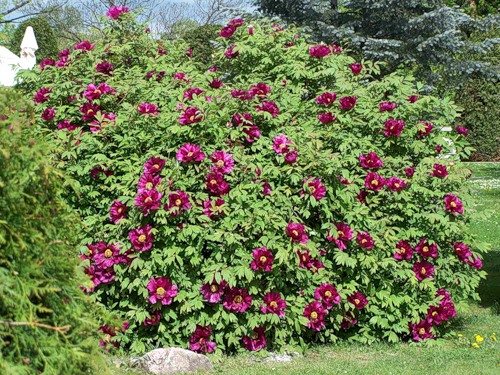

Tree peony care
When the peony takes root in your area and sprouts, this is only the first victory.Then, proper care of the plant is important throughout the season, from early spring to frost in the fall. Having studied the watering rate of the peony, protecting it from pests, helping to survive the difficult frosty months, you can extend the life of the plant, which will become your favorite, for many years.
Watering
The tree peony does not need frequent watering. Depending on weather conditions and rainfall, the plant needs to be watered 1-2 times a month. At one time in June-July, the bush will need 6-7 liters of water. After it is absorbed, the earth needs to be loosened. Beginning in August, watering is stopped. Weeds are removed as they emerge throughout the season.
Fertilizing and feeding plants in spring
While the plant is young, the first three years are fed foliarly. To do this, about 40 g of mineral fertilizers are diluted in 10 liters of water, and the bush is sprayed with this solution after watering. The make-up passes through the leaves. More mature plants are fed three times a year: in early spring, when young shoots appear; during the period of swelling of the kidneys; after the end of flowering.
Diseases and pests
Tree peonies do not get sick often, but like any plant they are susceptible to fungal diseases. Gray rot is considered more common. Due to excessive moisture in the soil, a lack of sunlight, a gray bloom appears on the stems and leaves. Brown spot is also one of the diseases of the peony. If you notice these signs, cut off the affected stems and burn them. Spray healthy stems with a solution of potassium permanganate 3 g per 10 liters of water.
Pruning and preparing peonies for winter
The tree peony is considered a frost-resistant plant, but to be sure that the shrub will overwinter and will please with new flowering in the spring, take care of insulation. Preparation should begin in October, pulling the stems as much as possible, but so as not to damage them. Cover the soil near the trunk with straw or pine branches, Christmas trees. With the onset of frost, cover the tree peony bushes with burlap, thick paper or polyethylene. In the spring, after unpacking, cut off the damaged branches, and shorten the healthy ones by a third.
A noble tree peony requires planting and care according to its own rules. Not so capricious in his homeland in China, he hardly takes root on the territory of Russia. In an informative interview, the video below tells you how to properly care for it. Breeders are trying to outwit nature by grafting a tree-like peony on the root of a herbaceous one, which has long been popular among summer residents and owners of private houses.
Having dozens and even hundreds of varieties of tree peony in your arsenal, choose flowers with different flowering periods and color palettes. Before one bush has time to bloom, the second will only begin to play with bright colors of cups with huge double petals. The video below once again reminds of the peculiarities of caring for this unique imperial plant, which has existed for over 100 years.
The tree peony flower is a hybrid form from the Peony family. There are about 500 species, most of which grow in China. It was the Chinese breeders who were the first to begin breeding work on tree-like flowers. A little later, the Japanese joined them. This representative was brought to Russia in the 18th century and immediately won the sympathy of gardeners.
How to shelter a tree peony for the winter
Many gardeners ask what to do with a peony when it has bloomed, and how to prepare planting for winter. It is necessary to cut off the faded shoots to the top point. It is necessary to feed the plant, bring bone meal and wood ash under each bush, after which the soil must be carefully repaired.
You may be interested in: Batun onion, planting and care in the open field before winter in your garden
Treelike peonies are cold-resistant, they can overwinter without difficulty. But it is still better to cover the tree peony for the winter.Frosts are not afraid of them, but sudden spring thaws can seriously harm. In October, it is necessary to carefully tie the shoots, mulch the trunk circle with peat. As soon as the cold comes, the peony bushes need to be covered with jute bags. You can build a hut of foliage, spruce branches or a thick layer of crushed bark over each bush.
It is recommended to add a little sand to the base of adult bushes in the fall, and rotted compost on top. If the landing site is not entirely successful, you can wrap the bush with spunbond. When growing bushes in a good location with no wind, you don't need to cover the bushes. Even if, after warming in the spring, frosts hit and the buds freeze, the peony will bloom, but in a smaller volume. And next year, the peony bushes will fully recover.
Description of the flower
Chinese peonies fell in love with and took root in the orchards of many floriculture lovers
... These magnificently blooming oriental beauties can delight with their splendor for more than one year. Peonies are a semi-shrub crop that does not require annual planting. Since the shoots are covered with lignified bark during growth, they are not afraid of winter cold.
Plant of a deciduous-shrub type
with stems growing up to 2 meters. True, this will take a long-term period. The stem is thick, erect, light brown in color. Unlike the herbaceous peony, they do not die off every year, but grow on the sides. The result is a sphere-shaped bush. Differs in unusual openwork foliage, sometimes a purple hue.
Lush large flowers with a diameter of up to 20 cm can boast of special beauty. They are divided into double, semi-double and simple. Colors abound in variety
: white, red, pink, yellow, purple. There are even multicolored ones. The flowering period of a tree peony begins a little earlier than that of a herbaceous one. The older the peony tree becomes, the more flowers bloom on it.
Characteristics of the species
The arboreal peony is a deciduous shrub that reaches no more than two meters in height. Stems are thick, light brown. They do not die off in the fall, but only grow, the plant gradually acquires a hemispherical shape. The leaves are openwork, ornamental. The flowers are large, up to 18-19 cm in diameter. There are semi-double, double and simple. Any color: peonies are crimson, purple, yellow, pink or two colors. The older the bush, the more flowers bloom. The tree-like peony blooms for two to three weeks. Almost all species are cold-tolerant; shelter for the winter is not required in most regions.
Types and varieties
For all cultivated peony varieties
, the following varieties became the primary source: Lemoine, yellow, Dalaveya, Potanin. All varieties are divided into three main groups:
- Chinese-European - all varieties have voluminous, double flowers drooping under their weight. The color ranges from pale pink to purple.
- Japanese - stand out with lush and airy flowers, small in size.
- Hybrid - a mixture of Dalaway peony and yellow. They are appreciated for their bright yellow color of flowers.
Caring for a room gerbera at home
Among gardeners, are in special demand such varieties of tree peony:
- Sisters Kiao - flowers have a two-color color: white and red. Bud diameter up to 17 cm.
- Sapphire is an unusually flowering bush with many pink-colored inflorescences and a raspberry center. The size is about 18 cm.
- Coral altar - has two-colored, crown caps, up to 20 cm in diameter. White color alternates with salmon.
- Green Jade - original flowers in the form of buds, greenish tint.
All representatives are frost-resistant, unpretentious in care. They can delight with their beauty up to 50 years.Even with strong freezing of the roots, they do not die, they only stop blooming for two years.
Peony tree-like timing and duration of flowering
The flowering time of a plant depends on the variety. It can start in May, June or July. The flowering period is 12 to 14 days. Peony flowers can be medium, large and small, and also have different shades from white and purple to purple and lemon green.
The inflorescences themselves can resemble roses, lotuses and even chamomile. Blooming peonies not only delight the eye with their beauty and grace, but also fill the garden with a subtle fragrance.
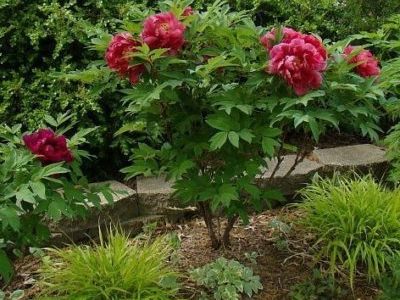

Planting and growing
The tree peony is planted in late summer or autumn. First of all, choose the most suitable place
... In this case, it is better to place the landings on a well-lit, mountainous area. Away from anything that can cast a shadow. Preference is given to a loamy substrate, which includes peat, humus, turf and clay. In addition, the soil is flavored with sand and mineral inclusions.
Try to avoid groundwater close to the surface. If it does not work out, then gravel drainage is laid on the bottom of the cone-shaped pit. A layer of earth is poured on top. The roots are laid on top, and are abundantly moistened with water. Do this until the roots are completely spread out. Sprinkle the plant to the root collar. If the medium is acidic, it is better to add a little lime. Saplings are located at a distance of at least 1.5 meters
between themselves.
Growing tree peonies from seeds is troublesome and not always successful. In this case, flowering occurs only after 5 years. The germination rate is low. Before sowing, the seeds must undergo a double stratification: warm and cold. Only this step will not give a 100% guarantee of high germination.
Growing freesia at home and in a flower bed
Shelter for the winter
Adult tree peonies do not need to be covered for the winter, it is enough to tie the shoots and mulch the trunk circle. But young bushes up to 5 years old must be protected from frost and gusts of wind. You need to start work after establishing a stable subzero temperature in November:
- Small bushes can simply be covered with a bucket of a suitable size and the container can be fixed in place with a heavy stone.
- Large bushes with twine tied shoots can be covered with a barrel or cardboard box of a suitable size.
- In November, the tied shoots of an adult ornamental shrub can be additionally wrapped with geotextiles, cotton linen or burlap. The color of the material must necessarily be white, since dark shades will lead to heating and untimely awakening of the kidneys.
- You can traditionally create a shelter from spruce branches by throwing it over a bush and fixing the "hut" with twine.
- Experienced gardeners create a wooden or wire frame around large shrubs, which is filled with fallen leaves and wrapped with a covering waterproof material. At the bottom it is necessary to leave a gap, which will serve to ventilate the contents of this "house" during periods of thaw and prevent the branches of the tree peony from overheating.
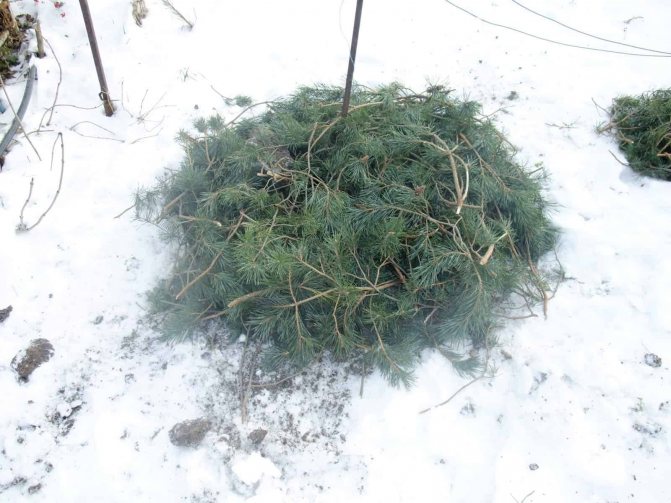

If you have the opportunity, after each snowfall, it is advisable to visit the site and carefully shovel the snow to the tree-like peony or to the shelter created. This measure will help protect the shoots of ornamental shrubs from gusts of wind and birds.
Tree peony care
If a tree peony does not bloom, although it was planted more than one year ago, then this is a consequence of improper planting or care. If there is no information about caring for a tree peony, then you can take care of a herbaceous one as a basis. The regulatory list is:
Gardeners should be aware that tree peonies are the highest consumers of fertilizers containing nitrogen and potassium. They need nitrogen in the initial growing season.At the stage of bud setting and before the end of the growing season, potassium and phosphorus fertilization will be required. It is just not recommended to overdo it with nitrogen. This leads to gray mold disease. So that the roots do not get burned, before fertilizing
, the soil is abundantly moistened with water.
Pruning must be carried out every spring: dried shoots are removed, old ones are shortened. Chinese gardeners prune their peonies every 20 years to ground level. This renews the plant and gives it more lush growth and flowering. We recommend doing the same. How long peonies will live and flourish on your site depends on this procedure. With proper care, tree peonies can live for about 100 years. There are even 500-year-old peonies in China.
Despite the increased vitality, the flowers do not tolerate transplanting well. Many begin to ache and wither, cannot recover for several years
... If such a need arises, then be careful with the root system. The roots are captured along with a clod of earth. Carefully cleaned with a jet of water and inspected for affected areas. Diseased roots are removed and sprinkled with crushed coal.
Indoor geranium: features of growing and care
Possible difficulties in growing a tree peony
Gardeners who decide to decorate their homestead with this beautiful, ornamental plant often face a number of problems regarding the cultivation of this luxurious flower. These include:
Lack of flowering peony - there may be several reasons for this problem. They consist in too much deepening of the root system, freezing of flower buds due to insufficient shelter of the peony for the winter or too acidic soil. After eliminating all the above problems, the peony will definitely bloom next season.
Lack of peony growth - it should be noted that the peony grows very slowly, however, if the plant is more than five years old and there is no growth, the reason for this may be improper planting, which led to the deepening of the roots or a lack of fertilizers necessary for growth and full development.
Rolling the leaves of the peony - most often, such ailment as gray rot leads to leaf curling. To eliminate it, the plant should be treated with Actellic according to the instructions on the package.
Peony leaves yellowing - the reason for this is the ants that have settled under the bush or the soil is too heavy with a minimum of nutrients. To eliminate both of these problems, transplanting the plant to a new place in a nutritious soil suitable for peony will help.
Withering and drying of the plant - the plant may wither and dry due to lack of moisture and sunlight. Also, this problem can be caused by a soil that is not suitable for a peony and a lack of fertilizers. In most cases, it is solved by transplanting to a new place with conditions ideal for the flower.
Poor survival of tree peony - the reason is improper planting or unsuitable conditions for the plant. Having created the necessary microclimate for the peony and making its correct planting, guided by the advice of experienced gardeners, the plant will surely take root and grow.
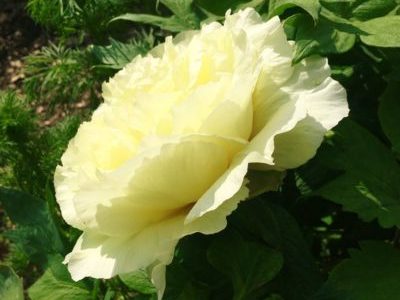

Reproduction methods
Reproduction occurs: by dividing the bush, layering, grafting and cuttings. When dividing, the bush is carefully stretched into pieces in the area of the root collar. In case of forced cutting, the exposed areas are processed. Before planting, each section is immersed in a clay mixture. For this method, only adult bushes that are at least 5-6 years old are suitable.
For grafting, choose only lignified shoots
, with multiple buds. The leaves are cut in half. The cuttings are immersed in a peat-sandy composition, watered and covered with a film.They carry out this procedure in June and continue to take care of them until September. For the winter period, they are seated in separate pots and kept in a greenhouse until next spring. With the first heat, peonies can be transferred to open ground.
The duration of reproduction by layering is 2 years. In May, low-lying branches are selected, partial cuts are made and sprinkled with earth. For fixation, insert a peg. In autumn, after the shoots have taken root, they are separated from the uterus and planted separately. There is one more way, however, ineffective. Shoots are also notched, wrapped in wet moss and polyethylene.
In industrial production and in private gardening, the most common breeding option is by grafting. For this, a stalk with two developed buds on the surface is taken. One end is sharpened under the wedge and inserted into the root system. The junction is wrapped in foil. Grafted peony
fits in a box with sawdust, is regularly moistened. Stored in greenhouse conditions. After one month, the cuttings are rooted in separate containers. The duration of full survival is from one to two years.
How to trim
Pruning peonies for the winter begins with the preparation of the tool: the garden pruner needs to be sharpened, treated with an alcohol-containing substance for disinfection.
Gardeners take powdered wood ash / potassium permanganate solution for cutting, humus or peat for mulching.
The order of work differs according to the types of representatives of the Peony family.
Pruning a tree peony
Caring for tree peonies in the fall involves removing the stems of an adult bush:
- Top three kidneys... The flower buds left below will be filled with strength, the next season the bush will be covered with large flowers.
- Once every 10-15 years to rejuvenate the bush, all the stems are cut to the border of the second bud from the ground.
- 0.7-0.9 m... This is formative pruning. It is needed when the plant loses its aesthetic appearance: the branches become spreading, too long, the flowering process is sluggish, and the flowers are small.
Every gardener should know that the harder you prune a peony bush in the fall, the fewer flowers it will throw away next summer. Proper care keeps the culture alive for up to 60–80 years. Rules:
- the sections are treated with a disinfectant;
- the plant is watered abundantly, the space around it is mulched with humus (peat) to preserve moisture and protect the roots from frost;
- in regions with harsh climates, shelter is needed for the winter.
Herbaceous
Pruning a herbaceous peony is carried out with pruning shears, keeping the blades parallel to the ground. The cut is made at ground level. After the stems are treated with ash or manganese solution. Watering abundantly will reduce the stress of the plant after cutting the vegetative organs. The remains of the stems are removed, the area around the bush is covered with a layer of mulch from peat (humus) so that excess moisture or frost does not penetrate to the roots through the cuts. Mulching with organic fertilizers serves as plant nutrition.
Diseases and pests
The tree peony does not belong to sissies; it staunchly resists any diseases. Only this attack can overcome him. This happens with poor care, as well as with a transplant. Gray rot is common. Then it is necessary to spray the entire ground part with a solution of copper sulfate. Leaves that cannot be saved are removed and burned.
Unlike herbaceous, they are a shrub structure that can grow in one place for many decades. They do not need a transplant, on the contrary, they experience it very painfully. Annual growth stiffens and winters well even in harsh conditions. You need to understand that the birthplace of the tree peony is China, and there are also cold and snowy winters there, so this does not scare him.
How to prepare a tree peony for winter?
Despite all the unpretentiousness and stability of tree-like peonies, they still need proper preparation for wintering, otherwise all growth over the past five years may be destroyed by one single spring thaw.
So, what exactly is the preparation of a tree peony for winter? First of all, you need to cut it off. This is done with the onset of the first frost. How to prune a tree-like peony for the winter: you need to cut off almost the entire aerial part, up to the upper axillary point. Even if you cut off less, the shoots left will still die off.
Shelter for the winter tree peony
As we have already said, sheltering peonies for the winter will save them from both winter frosts and early spring thaws. The latter are terrible in that at the first warming, the plant can start growing, and the subsequent frosts will destroy the buds that have hatched.
According to experienced gardeners, it is not difficult to insulate a tree peony for the winter. First, you need to sprinkle the near-trunk circle with peat, and with the onset of frost, you only need a few branches of spruce, of which you need to build something like a hut around. To prevent the hut from falling apart, tie the twine around the branches.
Alternatively, you can prepare oak leaves in advance and fill the frame built around the bush with them. It also needs to be covered from dampness.
The layer of peat with which you will sprinkle the ground around the bushes should be at least 10 cm.For the northern regions, you can increase it to 15-20 cm.This warm shelter will not only save the plant, but will also provide the nutrients necessary for growth and development in the spring. ... Peonies covered in this way will bloom earlier and more abundantly, since peat and humus will become a good growth stimulator for plants.
The tree peony is a wonderful hybrid shrub with large flowers and oblong dissected leaves. This species belongs to long-lived plants (their lifespan can reach 100 years). The shrub is hardy and hardy, but at the same time, capricious.
The flowering time of the tree peony falls on May-June. The flowers are large, about 20 cm in diameter and, depending on the variety, can be red, purple, white, crimson and pink.
Top dressing
The very first step in properly preparing a tree peony for wintering is feeding. It must be carried out before the dwarf shrub goes into the resting phase, that is, at the end of August or the beginning of September. For feeding, you can use complex preparations intended for ornamental flowering shrubs, the main thing is that they do not contain nitrogen. If this element enters the plant tissues in the fall, it will start the processes of building up green mass. Because of this, the tree peony will not have time to prepare for winter on its own and will freeze.
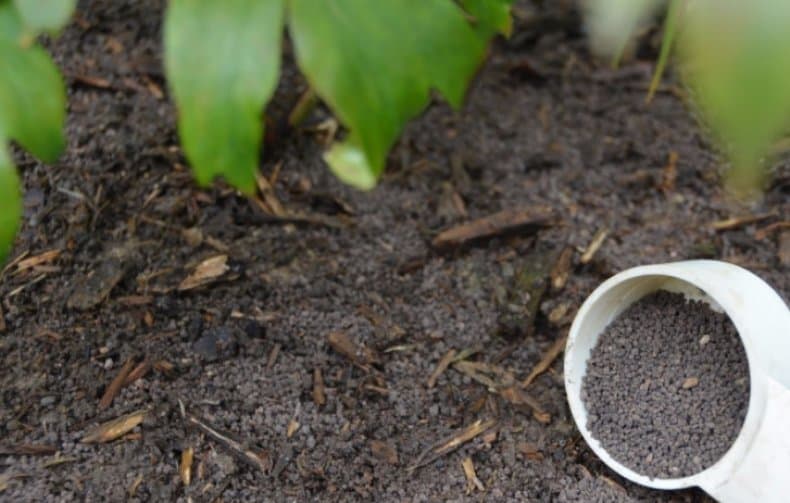

Complex feeding can be replaced with simple fertilizers. The tree-like peony responds well to a mixture of bone meal and ash (200 and 300 g, respectively), which is embedded in the trunk circle. Top dressing, rich in phosphorus, will help the shrub to better prepare for wintering and stock up on the nutrition that will be needed for the spring awakening.
The main varieties of tree peony
There are many varieties of tree peony, here are some of them:
- Red giant
- White jade
- Natural yellow
- Yin and yang
- Peach under the snow
- Black Panther
- Sapphire
- Malachite Box
- Scarlet Sails
- Gentle voice
- Twins
- Rainbow light
- Pink river
- Lily scent
- White crystal
- Red lotus
- The qiao sisters
- Intoxicating wine
- Emperor's Gold
- Shimanishiki
- Kinshi
- Pink lotus
- Pink lou
- Coral altar
- Coral tower
- Silk road
- Purple night
- Garnet bracelet
- Torch
- Red dress
- Blue doe
- Wine bowl
- Rainbow drops
- Two sisters
- Transparent dew
- Golden box
- White wanderer
- Imperial crown
- Indigo Chieftain
- Queen's whim
- Dragon wings
- Variegated butterfly
- Pink powder
- Ruby necklace
- White phoenix
- Green jasper
- Shining bouquet
It is better to purchase a tree peony in specialized nurseries or from trusted suppliers. As a rule, the cost of tree peony cuttings starts at 300 rubles.
For growing in the Moscow region and Siberia, you should choose frost-resistant varieties
, which bloom in late May and early June. Here are some of the varieties that have received the best gardener reviews:
- Pink lotus
- White Phoenix
- Black dragon
- Red Fortress
- Pink Bouquet
These varieties are Chinese winter-hardy.
For planting in central Russia, with a warmer winter, you can choose Japanese varieties:
- Hakujishi
- Rinpo
- Asahi-minato
Peonies tree varieties with photos and names
Yellow tree peony - one of the youngest hybrids, which looks not only amazing, but also very unusual. The height of the peony bush can reach up to 1.5 meters. Inflorescences are small, terry, bright yellow. Up to 40 flowers can bloom on the shrub during flowering. The plant has feathery, openwork leaf plates of a dark green hue. Flowering time falls at the beginning of summer.
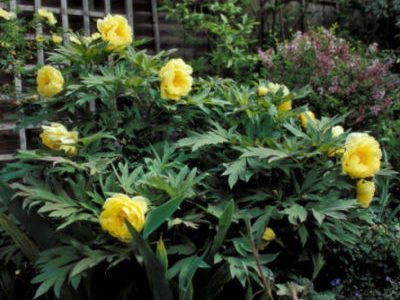

Peony Tree Red Giant - is a late frost-resistant variety, the flowering time of which falls on the last summer months. The height of the bush reaches up to 1.5 meters. The peony forms from 30 to 70 buds, from which large double inflorescences with a pleasant aroma appear. The leaf plates are feathery and dark green in color, retaining their decorative effect until the end of autumn.
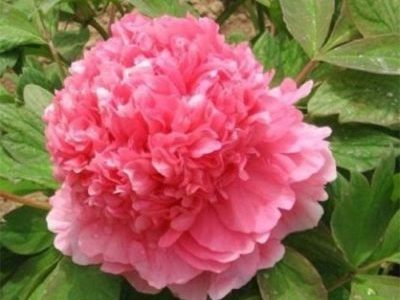

Peony Tree Kinko - this shrub reaches a height of 2 meters, is characterized by frost resistance and large, feathery rich green leaf plates. One bush can bloom from 30 to 70 buds, depending on the age of the plant. The inflorescences are large, crown-shaped and golden in color with a red border. Peony blooms in mid-June.
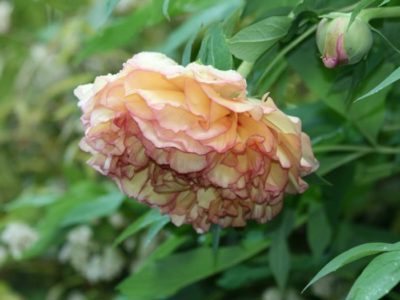

Peony Tree Sisters Qiao - This is one of the most unusual varieties of peonies. It has large, double inflorescences with a pleasant aroma and a two-tone shade. One side of the flower is red, the other is white. The peony bush reaches a height of 1.3 meters and has a beautiful dense foliage of a dark green hue. Peony blooms in June for two weeks.
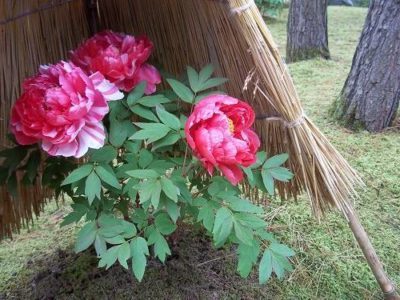

Peony Tree White Phoenix
The peony bush reaches a height of 2 meters. Due to the lush, feathery foliage of a dark green hue, the peony has a special decorative effect. Unlike other varieties, the inflorescences of this plant resemble non-intricate daisies with round, wavy white petals and a red core with golden stamens. The flowering time of the plant is in the middle of summer.
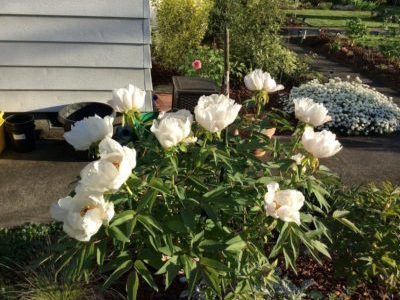

Peony tree purple - this unusual plant variety was bred in China. Peony inflorescences are large, terry. At a young age, they are dark pink, and after five years they acquire a bright purple hue. The shrub reaches a height of 1.5 meters and has small, dark green feathery leaf plates. The flowering time of the plant falls in late spring - early summer.
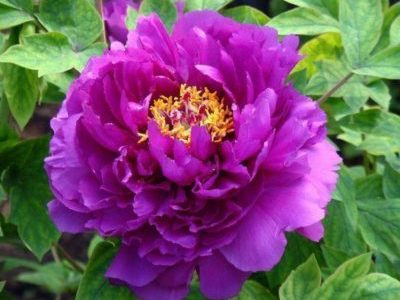

Peony Tree Blue Sapphire - is a medium early and medium vigorous variety, reaching a height of up to 120 centimeters. The leaf plates of the plant are pinnate, openwork of medium size, dark green in color. Peony blooms in mid-June. Inflorescences are large, terry, have a blue-pink tint with purple spots.
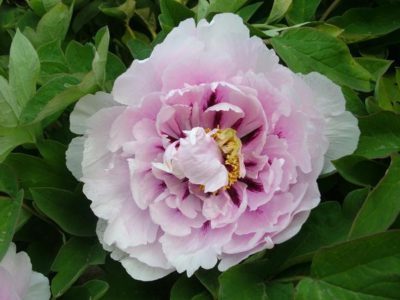

Peony tree black panther - a peony bush is wide, reaching a height of up to 2 meters. The variety is distinguished by frost resistance and disease resistance. The leaf plates are large, openwork, bright green. Inflorescences are large, semi-double dark red with a delicate, pleasant aroma. The flowering time of the plant is in mid-June.
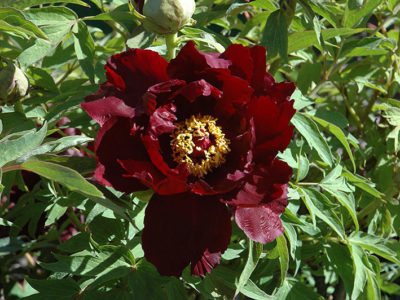

Peony Arboreal Gold Placer
The height of the bush reaches 1.5 meters.This variety is distinguished by its late flowering, which occurs at the beginning of July. The leaf plates of the peony are large, openwork, of a dark green hue. Semi-double inflorescences have a diameter of about 20 centimeters. A shade of peony of an unusual pale golden color with a pink frame around the edge of the petals.
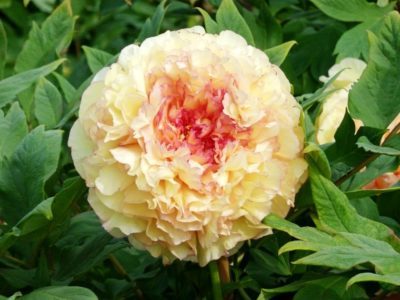

Peony Tree White Jade - the bush reaches a height of 1.3 meters. The inflorescences are semi-double, large, white in color with a pleasant aroma, resembling a lotus in appearance. The foliage is carved, medium, dark green. The plant blooms in late May - early June.
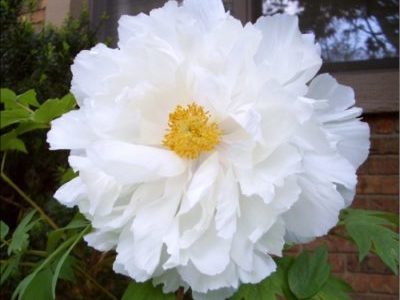

Tree Peony Shima Nishiki - one of the most spectacular varieties of peony. A compact shrub with dark green feathery large foliage, has long shoots with luxurious white inflorescences with red stripes. Peony blooms for two weeks in June.
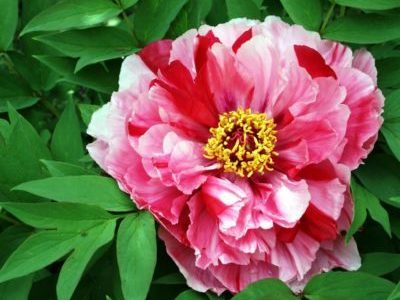

Peony Tree Green Beans - is a deciduous shrub with strong lignified branches, the height of which is up to 150 centimeters. The foliage of the plant is dense, feathery, rich green. The variety blooms late and is winter hardy. The inflorescences have a crown-globular shape and a whitish-lemon shade.
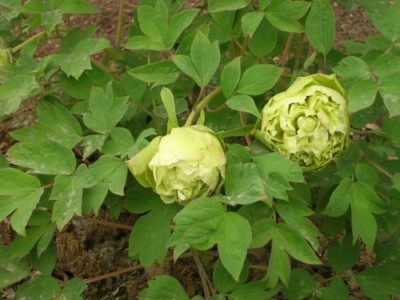

Peony Tree Transparent Dew
The variety is distinguished by late flowering, which falls in early June. The height of the bush with dense dark green feathery foliage is up to 150 centimeters. Large inflorescences have a spherical shape, a pink-blue tint and a delicate, pleasant aroma.
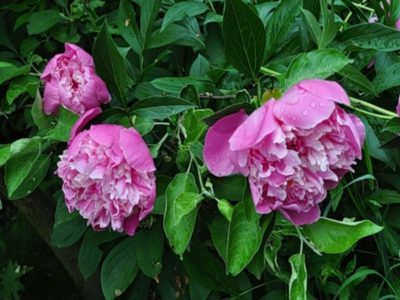

Peony Tree Green Ball - late blooming variety, characterized by frost resistance. The height of the bush reaches 1.5 meters. Leaves are dense, dark green, feathery. The inflorescences are large, outwardly resembling large, double roses. The peculiarity of this variety is that the opened buds at first have a greenish-lemon tint, then they change their color to pale pink or translucent. The plant blooms in early July.
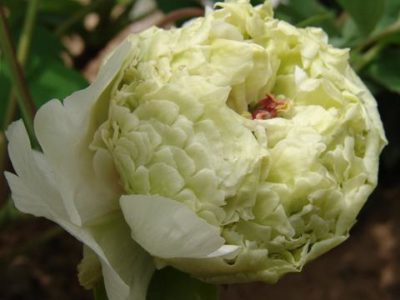

Peony Tree Scarlet Sails - the variety is distinguished by early flowering and frost resistance. The height of lignified shoots reaches 1.5 meters. The leaf plates are carved, lush, with a rich green hue. Inflorescences are large, double, purple in color. Peony blooms in mid-May - early June.
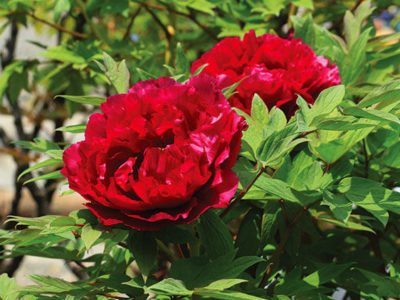

Peony Tree Twins - the height of the peony bush is from 110 to 150 centimeters. On the lignified stems, from 20 to 40 large chrysanthemum-shaped inflorescences of a purple-red hue with a pleasant aroma bloom during the flowering season, which falls from late May to mid-June. Peony leaf plates are large, carved with a rich bright green hue. The variety is resistant to diseases and low temperatures.
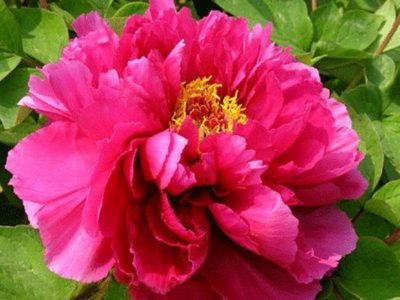

Planting a tree peony
The shrub is recommended to be planted during from the second decade of August
and until the end of September. When choosing a place for planting, it is necessary to take into account that it is better that it be away from large spreading plants, tall buildings and be protected from the wind.
The ideal soil for growing peonies is alkaline, therefore, before planting, add 200 gr. wood ash
.
For planting shrubs, a cone-shaped hole is dug on the site, 1 m3 in size. To the bottom of the pit drainage is poured
(broken brick, gravel), which ensures the drainage of melt water and does not allow the roots of the bush to rot. The drainage layer should be
about 20 cm
.
Then you need to pour a layer of natural soil, 250 g of lime and 150 g of superphosphate. After preparing the pit, the peony bush is planted.
Important,
so that the root collar of the peony (the junction of the root with the stems) is at the level of the soil.
When planting several shrubs, the distance between them should be not less than two meters
.
Agrotechnical care for tree peony includes concepts such as watering
,
feeding
and
pruning
.
- Watering
it should be
moderate
... As a rule, for a medium-sized bush, it is enough
6-7 liters of water
... Watering is carried out
2-3 times a week
... At the same time, the frequency of watering varies depending on the weather. In dry weather, plants are watered up to 5 times a week, but do not forget that the shrub does not like dampness. Remove all weeds and loosen the soil once a week before watering. - Distinguish 3 stages of feeding
tree peony.
During the growing season
nitrogenous fertilizers should be used. - During the budding period
potash and phosphate fertilizers are used. - During flowering
shrub, potash, phosphorus and nitrogen fertilizers are also used.
When feeding a peony, it is important to follow the instructions that come with the fertilizer, especially when feeding the plant nitrogen
... An overdose of this chemical element can cause root burns in a peony.
After planting a peony, foliar feeding is done for two years. To do this, the bush is sprayed with urea (40 grams of fertilizer per 10 liters of water).
- Pruning a tree peony
- the key to the correct formation of the bush. Anti-aging pruning is recommended
early spring
: With the help of a pruner, the shoots are shortened to the first living bud. Weak shoots must be pruned. Cut height -
10 cm
. - Transfer
... The bush is going through this process very painfully. Sometimes, after changing its location, the peony may be sore and not bloom. During transplantation, the root system is carefully removed from the planting site. Then the roots are washed with water and examined. Diseased roots should be removed, and the cut sites should be treated
1-% solution of potassium permanganate
and sprinkle with charcoal.
There are 3 ways of reproduction of this shrub:
- from seeds;
- cuttings;
- dividing the bush.
Reproduction of a peony from seeds is a complex process. As a rule, only breeders can propagate a shrub in this way. Seed propagation takes place within 2 years. Seed collection is carried out in the fall. Then the seeds are planted in open ground.
During the first winter after planting, the root system is formed. Then, after a year, the stems and root appear. With proper care, watering and feeding, the peony will appear 2 years after planting the seeds, and bloom for 4 years.
Propagation by cuttings is more efficient. Semi-lignified cuttings are cut in the second half of July. The cut cutting is placed to a depth of 1.5 cm in a container with a mixture of peat and sand, watered and sprayed with a ready-made mineral complex for shrubs once a week.
Peonies should be grown in a greenhouse or any other warm place. In the spring, if the stalk has grown, it is planted in open ground.
Reproduction by dividing the bush is carried out in the fall. Regardless of the type of peony, it is recommended to use peonies 5-6 years old. Root separation is carried out at the root collar. After separation, each root is dipped in a clay mash (a mixture of water and clay in a 2 to 1 ratio) for 30 minutes.
Peony tree reproduction by bush division
Reproduction by bush division is as follows. The grower needs to choose a mature plant with strong shoots. The bush must have at least eight branches. The division procedure is carried out in late summer - early autumn.
The selected peony must be dug up, cleaned from the ground and the root system must be rinsed. Then the branches are cut to a size of 10 centimeters and the roots are dried for about three hours in the shade. The finished plant is divided into several blanks, each of which must have at least two buds. Places of cuts are treated with crushed charcoal and fungicide.
To less injure the roots, they can be gently stretched without a knife, and before planting, be sure to dip them in a muddler made of clay.
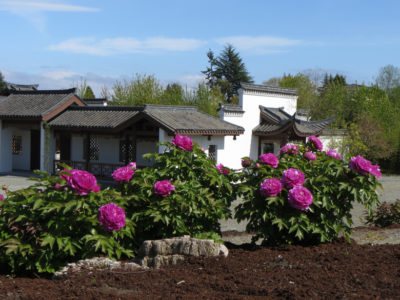

Preparing for winter
To shrub bloomed annually
, it is important to properly prepare it for winter.
To do this, at the beginning of October, the stems and shoots of the plant are tied with a rope and "covered" with burlap or straw.
Important!
The shoots are very fragile, so you cannot bend them to the ground in preparation for winter.
Tree peony
- shrub resistant to diseases and pests. But, with improper care, there is a risk of contracting diseases such as:
- gray rot
- a fungal disease, which is very dangerous, because can move to other bushes. When a peony is affected by this fungus, the stems and leaves turn brown and then dry out. Used for treatment
copper sulfate solution
(Dilute 10 grams of copper sulfate in 3 liters of water). The resulting solution is sprayed
1 shrub
; - brown spot
- a fungal disease that appears on the leaves of a peony and is an oblong brown spots. When the first signs of the disease appear, diseased leaves are plucked from the bush and burned, and the peony itself is processed
Bordeaux liquid solution
(one percent). Spraying the plant with a solution is carried out every 10 days until the spots disappear completely.
You can find out about the features of planting a tree peony and the differences from ordinary peonies in this video:
In autumn, peonies need special care that will help the plants successfully endure the cold season. When to cut peonies for the winter is a question that is relevant for all growers and owners of summer cottages. Correct and timely pruning will allow you to preserve the vital juices of the plant and prepare it for winter.
Features of spring pruning of tree and herbaceous varieties will be described in this article, and photos and videos will help novice growers to carry out the procedure correctly.
Pruning stems after flowering is one of the most important plant maintenance activities. Most often, novice gardeners ask themselves the question: is it possible to cut them immediately after flowering and how exactly to do it? Our article will try to clarify all the incomprehensible points regarding this procedure.
The main thing that you need to know is the fact that you cannot touch the bush for some time after flowering. Thus, we give him the opportunity to accumulate strength and nutrients for the formation of new kidneys.
Features of the
It is recommended to completely remove all faded buds for the first three years. However, do not rush to cut the buds as they fade. It is worth waiting for the whole bush to bloom, and only after that remove the bud along with part of the stem to the first leaf. This procedure will ensure more abundant flowering next year (Figure 1).
Note:
But, if you want to achieve not an increase in the number of flowers, but an increase in their size, the upper buds should be left.
As for the foliage, it is not recommended to cut it off unnecessarily, since the green mass plays an important role in the circulation of nutrients throughout the plant. In addition, cutting the leaves can only be done in autumn in warm weather.
How and when to properly crop flowers is shown in the video.
rules
Although it is not recommended to prune each flower immediately after it has grown pepper, it is worth making sure that the faded and fallen petals do not cover the bush with themselves. Excess moisture accumulates under the layer of fallen petals, which causes the development of mold and rot.
Figure 1. Timing and technology of pruning bushes after flowering
Trimming time
Pruning time after flowering is determined separately for each bush. The main guideline is the complete blooming of the whole plant. Only then can the buds be removed with small parts of the stems.
Content
- Peonies tree varieties with photos and names
- Tree peony care and cultivation in the Moscow region
- Watering a tree peony
- Soil for tree peony
- Tree peony transplant
- Top dressing of a tree peony
- Peony tree-like timing and duration of flowering
- Pruning a tree peony
- Peony tree preparation for winter
- Peony tree reproduction by bush division
- Propagation of a tree peony by cuttings
- Peony tree reproduction by layering
- Tree peony grafting
- Peony tree diseases and pests
- Possible difficulties in growing a tree peony
- Conclusion
When to prune peonies for the winter
Preparing plants for winter is a rather responsible event, because with premature pruning, there is a risk of ruining the entire flower. That is why the question of when to prune the bushes for the winter is very important.
Here it is worth focusing on the appearance of the bush. If all of its stems fall to the ground, you can start the procedure.
Features of the
Plants for the winter should be cut at the root. All removed parts of the plant (stems, leaves) should be taken outside the flower garden to prevent the development of pathogenic fungi. Cut bushes must be protected from frost.
rules
There are some rules that will help answer the question of whether you need to prune the bushes after flowering, and how to do it correctly.
For the procedure to be successful, you need to do the following
(picture 2):
- Start pruning for the winter after the first frost, when all the stems of the bush will fall to the ground.
- The stems of the plant should be cut almost to the root, leaving the shoots above the buds no more than 10 cm high.
- The remaining root system must be carefully covered from cold weather with humus or dry peat.
Figure 2. Pruning and covering bushes for the winter
First cold weather
Pruning of branches in the fall is not required for a tree-like peony, but to speed up the processes of preparation for winter, professional flower growers prune the leaves. This work is quite painstaking, but it helps to keep the ornamental shrub healthy and redirect the main nutrition to the root system and its rebuilding.
Use your garden shears to cut 2/3 of each leaf of the tree peony. The remaining third of the green mass will maintain a balance of nutrition through photosynthesis and respiration until it naturally begins to die off in time.
Even before the first frosts begin, measures should be taken to secure the tree peony in an unfavorable period. It is impossible to build a shelter at once, since the shrubbery in this case will "overwhelm".
By the end of September, carefully collect the branches and fix them well with twine. This measure will protect fragile wood from injury and scrapping from gusts of wind or freezing rain.
Next, you need to mulch the trunk circle, protecting the root system from the coming cold snaps and frosts during the snowless period. To do this, it is best to use dry peat and lay it out in a generous layer of 15 cm.In the northern regions, it is advisable to increase the thickness of the mulch to 25 cm.
Pruning a tree peony in spring
Pruning a tree crop in spring is the best way to care for a plant. The procedure involves removing old and broken branches, shoots with dried foliage, as well as shortening healthy shoots to the first living point in order to rejuvenate the entire bush.
Features of the
Pruning a tree plant in early spring is rejuvenating. At the same time, last year's shoots are shortened to the growth point, and the weak ones are cut so that 10-20 cm of the stem remains from the ground surface.
There is no need to be afraid to prune the plant every spring, because it tolerates this procedure well and quickly becomes covered with new shoots. In this case, specimens over 10 years old are recommended to be cut at the root.
rules
As in the case of herbaceous varieties, tree pruning is carried out according to certain rules.
Key features include
(picture 3):
- Pruning in early spring aims at bush formation and plant rejuvenation.
- It is also possible to carry out pruning of frozen shoots in late spring.
- In order to obtain larger flowers, it is recommended to remove a third of the formed buds during spring pruning.
Figure 3. Technology for pruning a tree variety
It is also necessary to remove the root growth from the rootstock if the bush was obtained by grafting.
Pruning a tree peony in spring: video
For those who have never pruned a tree plant before, we recommend that you watch the video, which shows in detail all the details of this process.
Spring work
In the spring, the shelters created should be gradually "disassembled" to prevent the shoots from drying out and lagging behind in awakening. If you shook snow, you should gradually remove it from the bushes so that ice crusts do not form on the near-trunk circle, which interfere with the normal respiration of the root system.
With the establishment of a plus daytime temperature at the end of March, the shelter of spruce branches or fallen leaves should be disassembled. If this is not done in time, the shoots will perepereut and the bush will die. If there is a threat of recurrent frost, the associated branches of the bush can be wrapped in a white cotton cloth or burlap and fixed with twine.
At the beginning of April, the shelter can be completely removed. Then it remains to wait for the buds to bloom and carry out rejuvenating and sanitary pruning, removing dried branches and frozen tops of the shoots. It is not worth rushing with this event, since those affected by frost, but the remaining living kidneys, may wake up later than the rest.
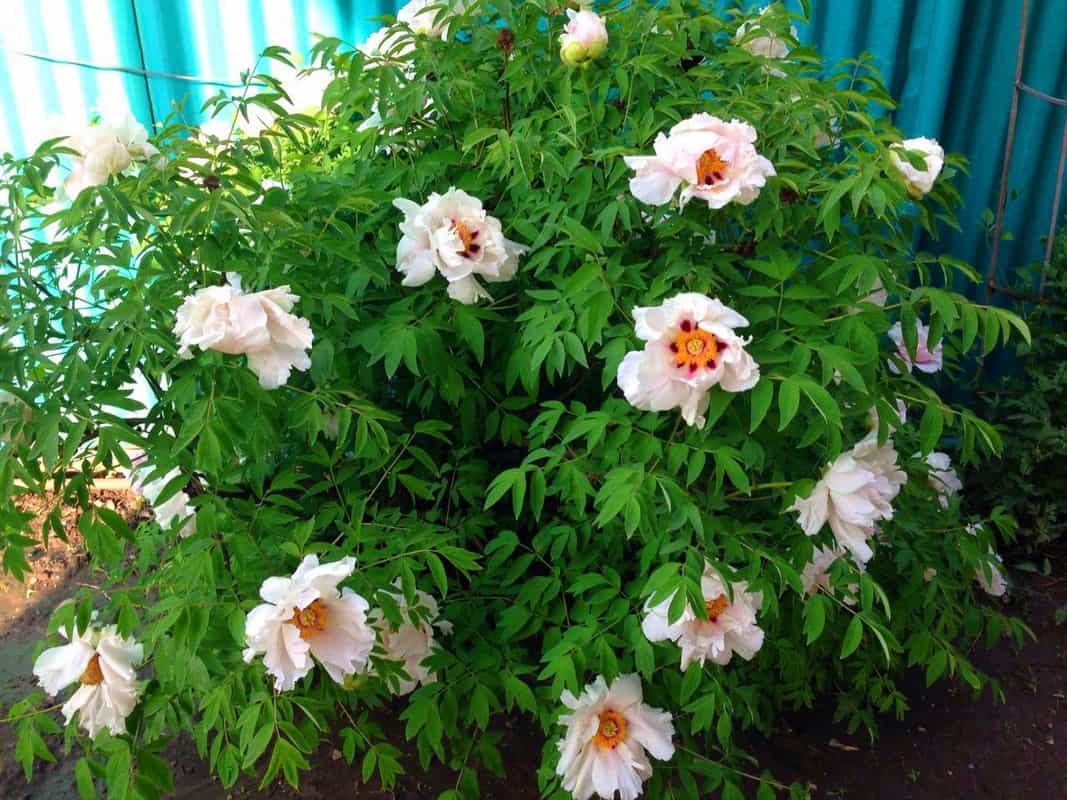

For more information about caring for this amazing shrub, see the video:
The tree peony is a shrub, although unpretentious, but still needs preparation for winter. Autumn work with a handsome foreign man takes place in several stages:
- at the beginning of autumn, the tree peony needs to be fed with a complex fertilizer or a mixture of bone meal and wood ash;
- before the first cold weather, it is advisable to shorten the sheet plates by 2/3;
- at the end of September, the shoots must be collected and fixed with twine, and the trunk circle must be mulched with dry peat;
- when establishing a minus temperature, a high-quality shelter should be created for the tree peony.
These activities will help the tree peony prepare for wintering and successfully survive frost and squally winds. In the spring, the shelter must be gradually disassembled so that the ornamental shrub begins to awaken in a timely manner.
Pruning a tree peony in the fall
In autumn, tree-like varieties cannot be cut off, since next year flowering will occur on last year's shoots, and the bush itself will not look lush and beautiful enough.
Features of the
Autumn pruning is sanitary in nature, that is, it is aimed at removing diseased or damaged shoots. If the bush looks healthy, there are no damaged parts or signs of disease, it is best not to touch the plant so that it can accumulate enough strength before winter.
Planting process
You will need to dig a cone-shaped hole. The diameter of the hole at the surface, as well as its depth, is approximately 60-70 centimeters. Then make a small layer of drainage from gravel, expanded clay or broken brick, no more than 20 centimeters. When planting several plants, you will need to maintain a distance of 1.5-2 meters.
It is best if the soil has time to settle - so the holes will have to be dug in advance, two to three weeks before planting.
Place fertile soil on top so that it forms a small mound. Now you need to plant and abundantly water the tree peony seedling. After a while, the earth will settle on its own, and the roots will straighten.
If there are buds on the tree peony seedling, they must be removed. After completely absorbing the liquid, fill the hole. There is no need to trample down the soil.
Secrets of the correct fit
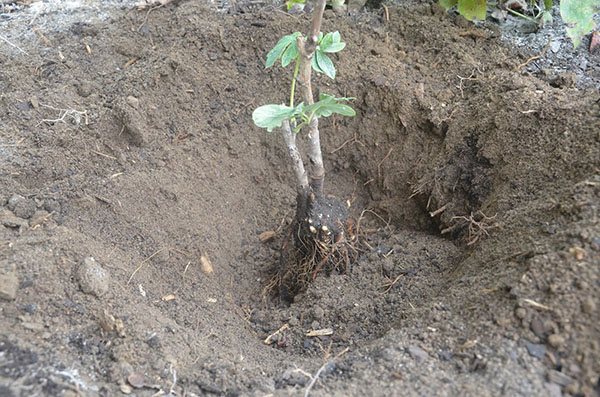

According to agronomists, planting a tree peony in autumn is the best time. To be more precise, this is the end of August - the beginning of October. It is during this period that the seedling will be able to take root and prepare to grow new shoots with the arrival of spring. A moderately sunny place, protected from drafts, is best for growing. Planting in the shade of a house or large tree will prevent the shrub from thriving and can lead to underdevelopment and stuntedness.
In order for the plant to have a presentable appearance in the future, you need to properly prepare the soil: add sand, be sure to clay, turf and humus. So it will turn out to be nutritious and at the same time it will be well aerated. If there is loamy dense soil at the planting site, then it must be mixed with sand and organic fertilizer.
Peonies do not like acidic soil. The soil for tree peonies should not be more acidic than pH 7. If necessary, a small amount of lime is added to the acidic soil.
Proven landing technology
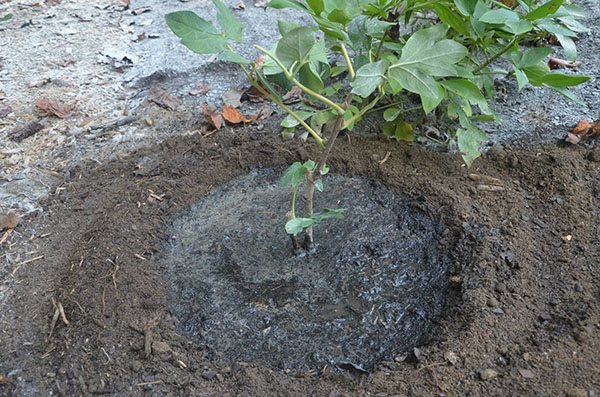

How to plant a tree peony in the ground so that it quickly takes root and grows? The main thing is to observe the landing technology:
- prepare a seedling (remove excess shoots and dry roots, treat roots from pests);
- dig a cone-shaped hole (about 80 cm deep and the same in diameter);
- ensure good drainage of the soil, covering the bottom with expanded clay or crushed stone;
- pour a part of humus with turf or chernozem on top of the drainage layer;
- a peony is placed on the nutrient layer and watered well;
- after the hole is covered with soil to the level of the root collar and compacted.
Correct planting and caring for several tree-like peonies in one area will bring good results if the distance between the bushes is at least one and a half meters.
How to store seedlings
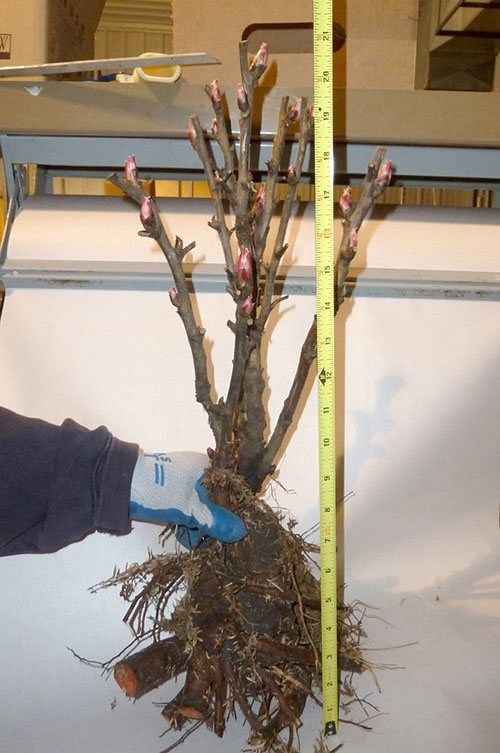

It happens that it was possible to acquire a peony only at the end of autumn, or even at the beginning of winter. Of course, it should not be planted at this time. During this period, it is important to properly preserve it until spring. To do this, you can carry out several preparatory measures:
- carefully examine the acquisition for rotten or dry roots, remove them with a sharp sterile knife;
- choose a small container that is suitable for the size of the roots;
- plant a seedling for the winter in nutrient soil in a container and put it in a basement or in a cool room.
The transfer container must have perforations for draining the water so that the roots do not rot.
The temperature of the outside air and the condition of the seedling will tell you how to properly plant a tree peony in the spring on the site. If the temperature in the room in winter was maintained at about zero degrees, then the shoots will not grow. The plant will grow the root system over the winter. And only with the onset of warm days will new buds appear. Planting technology should be the same as in the autumn period (good watering, drainage and nutritious soil). After planting, you need to try to pay attention and provide systematic care for tree peonies.
Care Tips


- There are regions where the soil is rich and complementary foods are not required. In the Moscow region, plants need to be fertilized in spring with nitrogen-containing substances, and in the fall with potassium and phosphorus.
- Before mid-October, in the fall, prune the peony and prepare it for winter. After the procedure, if the weather is dry, moisten the soil well.
- Remove all leaves that have fallen in autumn, as they can be breeding grounds for viruses and infections. Before freezing, cover the peony with spruce branches, peat and compost with a layer of 18 - 20 cm.
- In the spring, three-year-old bushes are fertilized with mineral complexes (it is enough to scatter 2 teaspoons around the peony).
- Remove the first flower before wilting, if there are 2 buds, then remove the top one. In the spring, sanitary pruning is done, and from grafted peonies, remove root suckers at the base. Last year's branches are cut 10 to 12 cm.
- Once every 5 to 7 years, the tree peony should be transplanted and the bush should be divided.
Pruning
The best time for rejuvenating pruning is during the early spring months. The plant is sleeping at this time, and when it wakes up, it quickly overgrows with new shoots. Strong shoots are pruned to a growth bud, weak ones - at a level of 20 cm from the ground. If the winter was cold, the frozen branches, if any, should be removed.
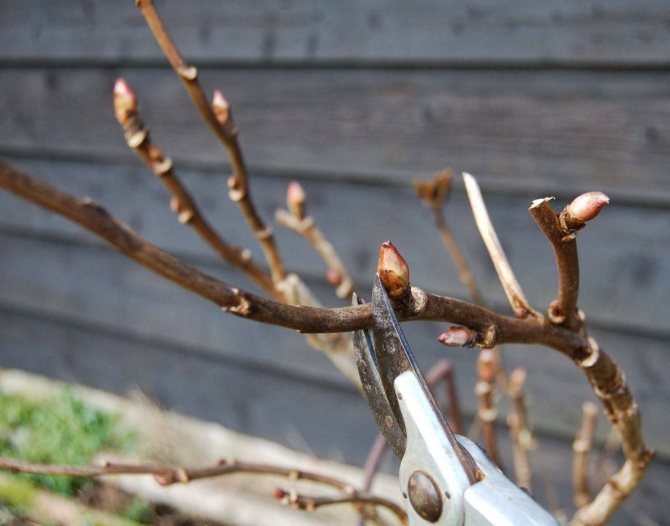

The largest and most lush peonies will be obtained if 1/3 of the buds are removed in the spring.
When the plant turns 8 years old, the number of inflorescences decreases, splendor decreases.In this case, it is recommended to remove the branches "under the stump".
Where to plant
The garden king loves the sun. The brightness of the color of the flowers and the duration of flowering depend on this. In extreme cases, partial shade is allowed, although there will be fewer colors. In the shade, the bush will also grow, but there will be no flowering.
The peony does not tolerate stagnant water in the roots. Therefore, the landing site is determined on a hill with good drainage or drainage of excess water.
The royal suite should consist of undersized or ground cover plants, because the peony will not tolerate tall neighbors and will quickly wither away. This is a solo plant that feels great on the lawn, but it will look good in a multi-tiered flower bed or in a monochromatic flower garden.
Blooming of buds can be delayed by pinching the central shoots. Flowers will open on the side shoots in 8-12 days. Thus, they regulate the sequence of flowering plants in the flower bed. You can achieve long-term flowering of peonies in the garden if you plant the bushes in places with different illumination. Those that grow in light partial shade will bloom 5-6 days later than those that live in the open sun.
The flower prefers slightly acidic loamy soil. If the soil is clayey, sand is added to it, and clay is added to the sandy soil. The acidity is balanced by the addition of lime.
Seeds are stratified before planting.
Caring for bushes after pruning
For successful wintering, active growth and flowering in the next season, peonies need to be fed in autumn with potassium (potassium phosphate), phosphorus (superphosphate) mineral fertilizers. According to weather conditions, they are brought in dry or liquid form:
- If the autumn is dry, phosphorus-potassium fertilizers are diluted with water according to the instructions, the plant is watered at the root.
- In rainy weather, it is better to scatter granules of chemical fertilizing around the bush (adhering to the dosage indicated on the package), slightly embed them in the soil.
Errors
Inexperienced growers make the following mistakes when preparing a peony for winter:
- Prune the plant too early for the sake of decorativeness. This cannot be done. The gardener's priority is plant health.
- Cut stems and fallen leaves are not removed from the flower bed in the fall, where microorganisms that infect flowers multiply.
- Disinfectants are neglected when pruning. Rot and other viral infections are bred, especially in unfavorable weather.
- Do not mulch the ground around the peonies. The soil dries up without rain, the root system is weakened, and the buds of resumption of growth are in danger of freezing.
The best varieties of tree peonies for the Moscow region
In the suburbs, you can plant a wide variety of peonies. They easily take root, bloom profusely, tolerate winters well. Due to their unpretentiousness, frost-resistant shrubs are used in landscape design.
The tree-like peonies of the following varieties are recognized as the best for the Moscow region:
- "August Dessert" with pale pink double or semi-double buds;
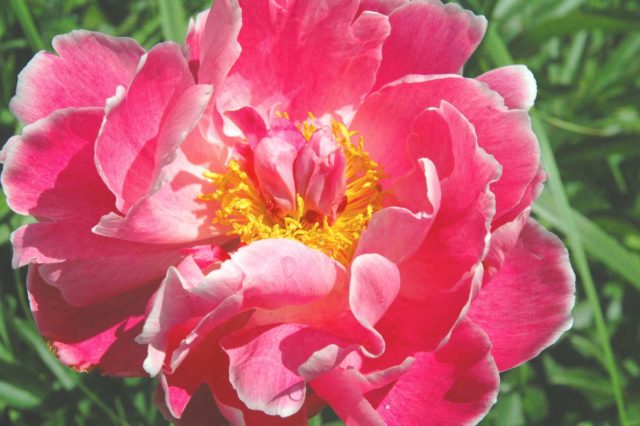

- Vesuvius - purple-red flowers remain open for up to 14–20 days;
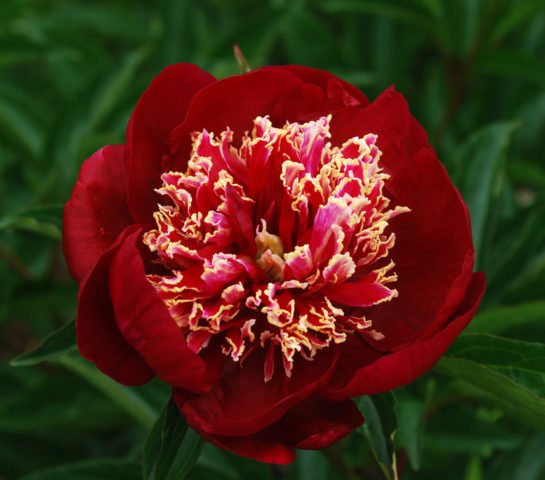

- "Maria" - delicate double buds with a pink heart;
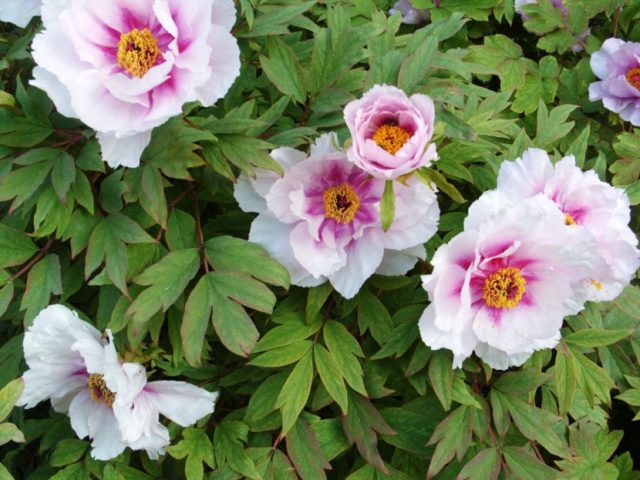

- "Hoffman" is a frost-resistant variety with large double pink flowers; is one of the first to dissolve;
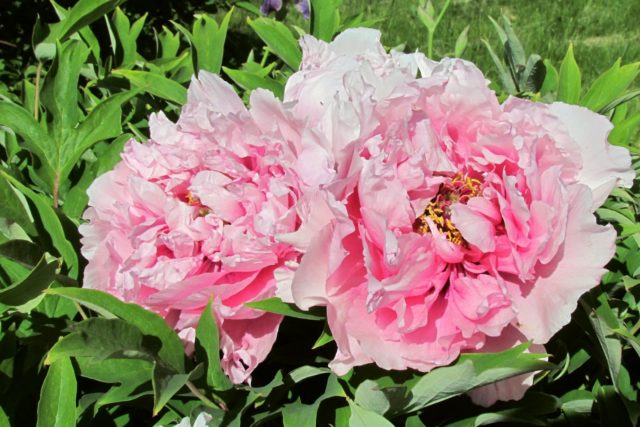

- "Blue Lagoon" - a tall peony with bluish-pink buds;
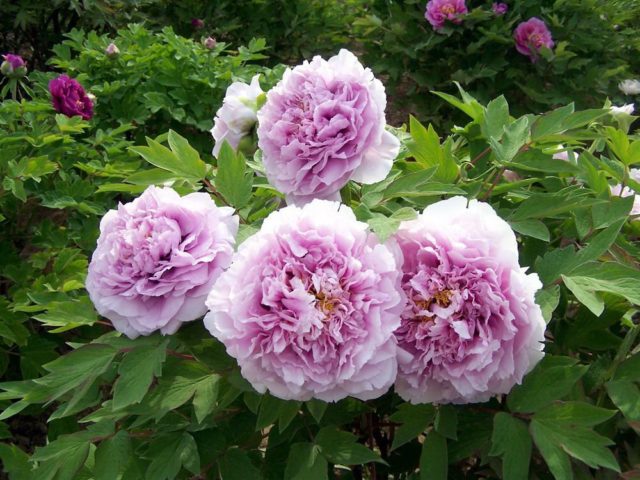

- "Spring Waltz" - early flowering, spreading shrub with a short flowering period (5-7 days);
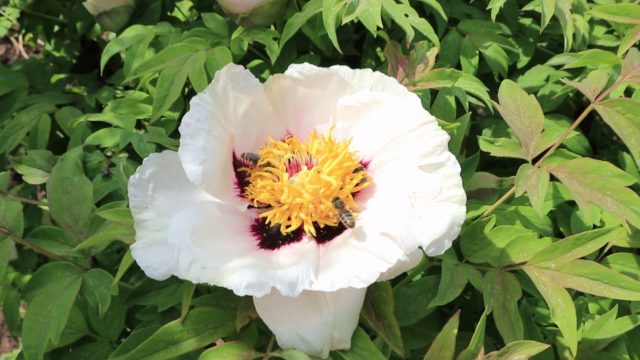

- Kuindzhi is one of the best varieties with spreading yellow inflorescences.
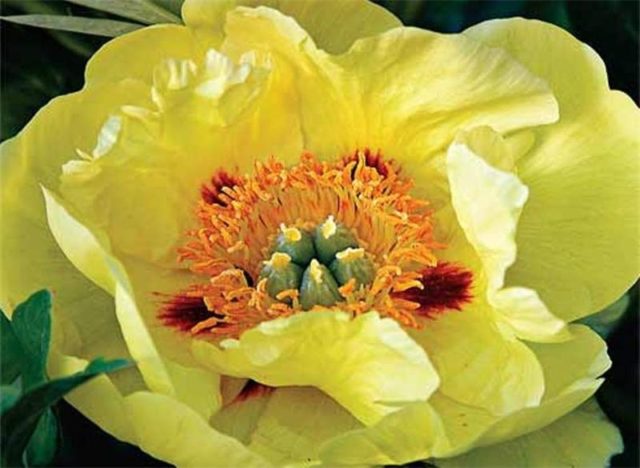

Frost-resistant tree peonies are recognized as the most unpretentious in care, cultivation and reproduction for the Moscow region:
- "Blue Sapphire" - grows quickly, blooms for a long time, withstands frosts down to -40 degrees;
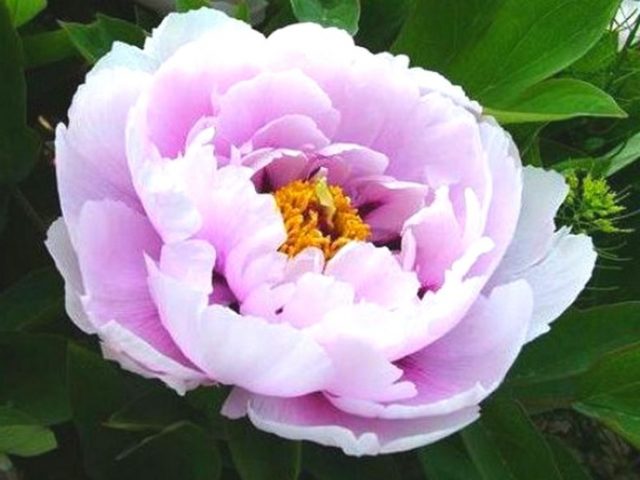

- "Scarlet Sails" - one of the first to bloom (in mid-May), releases up to 70 buds per season;
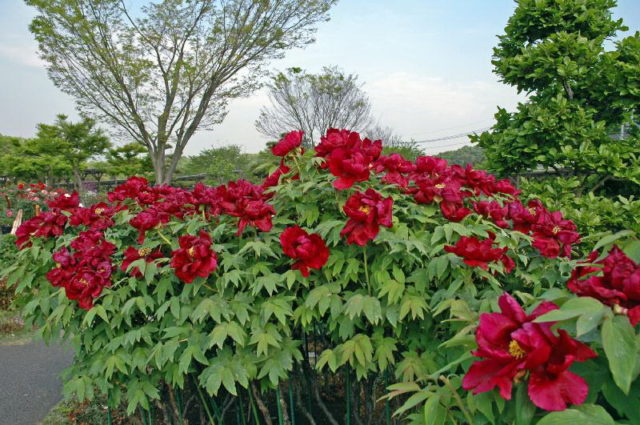

- The Jade Princess is a low, spreading shrub with lush white blooms.
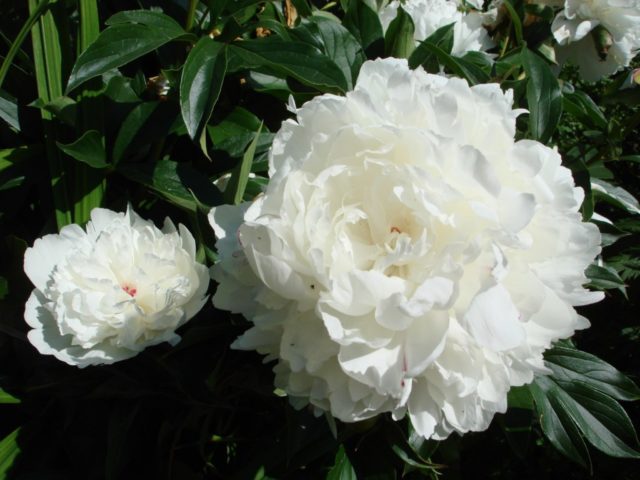

Breeders have bred more than 200 tree varieties of peonies, any of which, following the recommendations, can be grown independently
How to properly prune and transplant a tree peony
Pruning of a tree peony according to all the rules is carried out in the spring. The flowering of a perennial depends on whether it is done correctly.
During pruning, all old branches are cut out, and last year's are shortened by 10 cm. Old bushes are pruned at a level with the soil to awaken the adventitious buds, thus, the plant rejuvenates.
Correct pruning of a peony is the key to lush flowering in subsequent years.
A perennial very poorly tolerates a transplant, especially with age. Strong and healthy plants may die after transplanting. If a transplant is necessary, then try to carry it out carefully, without injuring the root system. Dig out a bush with a lump of earth, then rinse well under water and examine the roots. Remove all diseased and broken roots, slightly shorten the rest. Process the sections with a solution of potassium permanganate and sprinkle with crushed coal.
Pick-up location
The tree peony, according to the descriptions, prefers places where it is intensely illuminated by the sun in the morning and evening, and in the afternoon fall into the shade, the scorching midday rays shorten the flowering time. The plant does not tolerate gusts of wind, does not withstand the neighborhood with other shrubs, trees, buildings.
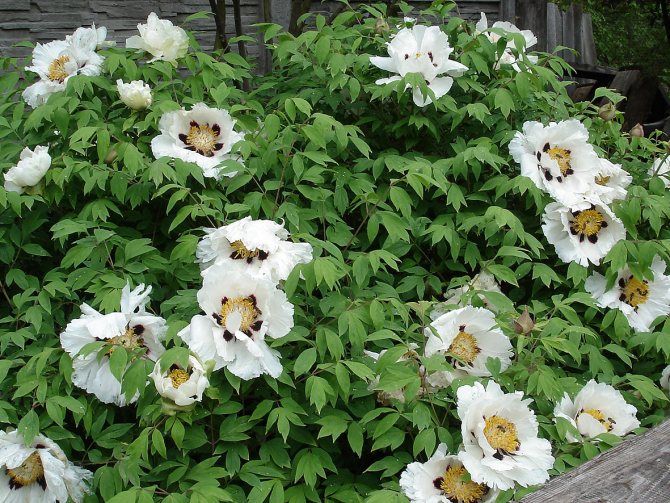

Choose a moderately shaded area in the east of your garden. Avoid planting in low-lying areas and places where groundwater accumulates. Storm water and spring snow can damage the plant. The ideal planting site is a hill with equipped gutters.
Plant the bushes in 1.2 m increments. The distance between peonies and other large shrubs is at least 2 m, otherwise the flowers will suffer from soil depletion. The same distance should separate the peony and the buildings, since they heat up in the summer and create an extreme background in their own way. The trees must be at least 3 m, otherwise the shadow will not let it bloom.
How to choose planting material
Peony seeds are rather large, smooth, rounded. They are dark brown in color and have a dense structure. They have a low germination rate, only 10% of the total. Therefore, choose seeds with the shortest storage period. Deformation and excessive dryness are the result of over-storage.
Planting plots are selected with a diameter of 10-15 cm. They should not have dried out or rotten parts. If there are any, they must be removed by disinfecting the cut points with crushed coal. To prevent the rhizome from drying out before planting, it is wrapped in a damp cloth.
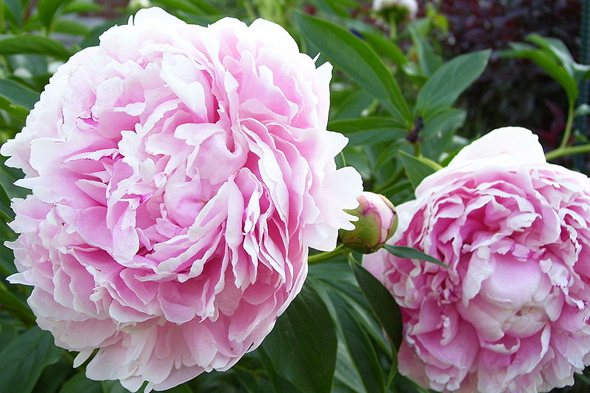

When choosing a planting material, one should pay attention to the varietal characteristics of plants, the nuances of agricultural technology. The most popular varieties of herbaceous peonies are Festiva Maxima (white with a pink border, very early blooming), Gold Mine (yellow double, early blooming), Henry Bockstoce (bright crimson flowers up to 22 cm in diameter, early flowering), "Sarah Bernhardt" (pale pink, abundant late flowering). Among tree-like peonies, Chinese varieties Brilliant Hu's Red - Da Hu Hong (Red pomegranate), Xue Ying Tao Hua (Peach under the snow), as well as varieties bred by Russian breeders: Anastasia Sosnovets (anemic white flowers with bright - pink center and black eye), "Vladimir Mayakovsky" (deep pink, semi-double) and "Kuindzhi" (yellow terry). Domestic breeding varieties are characterized by increased winter hardiness. Hybrid forms are no less relevant, such as Bartzella (pale yellow, terry inflorescences with an average flowering period) and Cora Louise (milky pink with a lilac eye, the budding period is medium).
Planting a drained peony in the suburbs
The procedure can be carried out starting from the second half of August and ending with the second decade of September, since the seedling must have time to take root and adapt before the onset of frost.
If you already have one plant, and you want to propagate it, then first divide the bush into several parts.
- Remove all stems and gently dig around the entire bush. It is important not to touch the root processes.
- If the soil is dry, moisten it first. Lift the plant carefully out of the ground. Rinse the roots with warm soft water and determine the peony to dry (at least 24 hours).
- If the rhizome is very large, then in the middle it is necessary to drive in a wooden peg so that it is more convenient to separate it.
- Examine the root collar and processes. Clean from rotten, damaged and dry areas. If the processes are very elongated, then shorten them to 18 - 20 cm.
- Each part should have 3 to 5 buds. All procedures are carried out with a sharp instrument, previously disinfected.
- Sprinkle the places with finely crushed activated carbon. Then immerse the young plant with the roots in a potassium permanganate solution for 2 - 3 hours.
- Place the separated parts in a dark place to dry out and form a cork layer. Some growers additionally treat with a solution of heteroauxin (2 tablets per bucket of water).
- Next, we plant the plants.
Spring planting is done more frequently. So there is still a lot of time left to recover from stress, adapt and prepare for the harsh winter that often happens in the Moscow region.
Breeding process
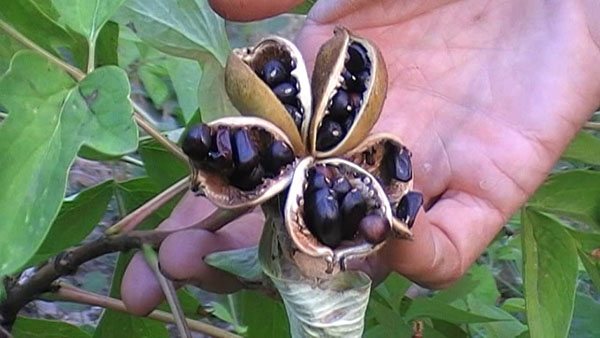

Growing a tree peony is a fun process, especially when breeding existing specimens. After all, you can get more colors in several ways:
- divide an adult bush into several parts;
- root a few cuttings in the ground;
- get layering;
- grow new plants from seeds;
- plant a new variety on an existing shrub.
Dividing the bush
Tree peony, care, reproduction of which takes place in compliance with agricultural technology, brings good results. For division, a large plant is chosen and dug out so as not to damage the root system. Then it is divided by cutting with a sterile sharp knife. You can divide not only in half, but also into more parts. The main thing is that there are at least four shoots on the parts.
When cutting, you need to try to minimize the damage to the roots and not introduce the virus into them. For this, the cut sites are treated with a pink manganese solution and covered with charcoal or activated carbon powder.
For division, you can not take plants younger than five years of age.
Getting layering
To propagate a tree peony with the help of layering, it is enough to bend the lower branch to the soil, cut the outer part of the trunk, sprinkle with root powder and cover with soil. In this case, the branch will continue to feed on the mother plant. And soon it will put down independent roots and new shoots. When can a tree peony be transplanted and separated from the main bush? It is with the growth of new shoots. It is best to root the cuttings in the spring, and plant the young specimens in a separate container in the fall.
Cuttings
For grafting choose a strengthened bush, 4 - 5 years old with good woody branches. The best time for the procedure is the beginning of July. The cuttings will have time to take root before the onset of cold weather. To plant a stalk, cut off a part of the stem with several buds. The upper cut is made straight, the lower cut obliquely. In order for the sprout to take root well, the lower cut is treated with a stimulant (root). The soil also plays an important role in rooting: you need to use peat and sand. It is better to water the seedling with warm water. After watering, it is covered with a jar or cut plastic bottle. If possible, use a mini greenhouse. It will be possible to understand that the cutting has taken root by the new shoots, which it will eventually start up.
Graft
To carry out the vaccination procedure, you will need some skill and, as gardeners say, "light hand".For cuts, necessarily sterilized instruments are used; it is better to carry out work with gloves. Usually, a varietal (terry, multi-colored) is grafted onto a simple strong bush. A branch is cut from a varietal plant, the lower part of which is cut in the form of a wedge. On the main bush, the lower branch is selected and a part is removed from it, also in the form of a wedge, into which the scion is driven. The junction must be treated with garden varnish and wrapped with foil.
Not all vaccinations are successful. In order for everything to work out, you need experience and the right time for the work. August is best suited for this.
Removal from seeds
How to care for a tree peony to get good seeds? It is necessary to leave the largest and most beautiful inflorescence, without cutting it off after wilting. And give the seed pod to ripen properly. The resulting seeds are pickled and prepared for winter planting in a container. Sprouted shoots are dived and transplanted into the peat mixture in the spring. It is impossible to plant young growth immediately in open ground, otherwise it will die. The best conditions for young animals can be created in the greenhouse.
Getting a plant from seeds will not work quickly. And it may take several years before flowering. The seed propagation method is often chosen by breeders for breeding new species.
The best early varieties and hybrids of peonies in Pomoskovye
This section of the article lists very early and early varieties of peonies and names - they all bloom at the very beginning of June.
"Aritina Nozen Glory". The bush is beautiful, reaches a height of 70 cm, leafy, semi-spreading. The buds are lilac-pink in color, 20 cm in diameter. The flower has one row of wide outer petals. The stamens are bright yellow, collected in a pompom. The stems are pubescent, straight, strong. The leaves are large, carved, light green.
"Pearl placer". The bush reaches a height of 80-85 cm, slightly spreading. Japanese-style bud. The description of the color of this peony variety resembles the AritinanozenGlori variety - the inflorescences also have lilac-pink colors, but their diameter is slightly smaller (up to 14 cm). The stamens are modified, with bright pink tips. The flower is densely double. Feature - the bush grows quickly. Stems are straight, leaves are small, bright green.
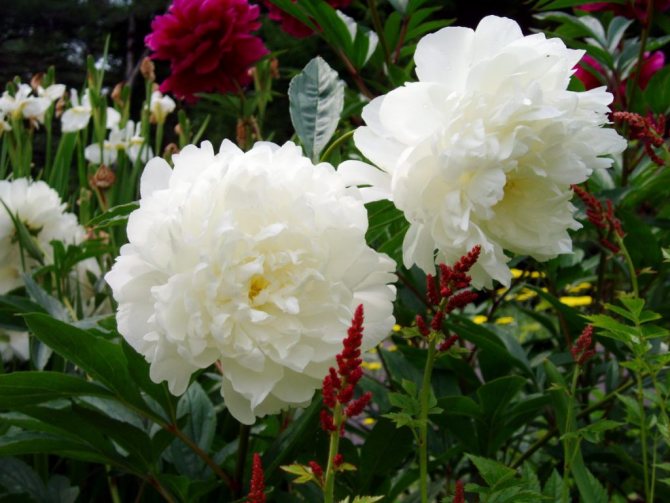

Ann Berry Cousins. The bush reaches a height of 90-95 cm, compact, slightly spreading. Coral pink buds with yellow stamens in the center. The diameter of the flower is about 16 cm. The petals are arranged in 5-6 rows. Has an unusual luminous color. The leaves are quite large. Stems are thick, firm, slightly deviated, light. The foliage is dense. The hybrid of this variety of peonies is simple, semi-double.
Lastres. The bush reaches a height of 70 cm. It is compact enough. Beautiful buds of bright red color, yellow stamens with red veins. The diameter of the flower of this variety of peonies is about 19 cm. The buds are arranged in 4-5 rows, the stems are thick, with large leaves, light. The leaves are bright, shiny. The flower is semi-double, has a pleasant unobtrusive aroma. Looks good in a bouquet.
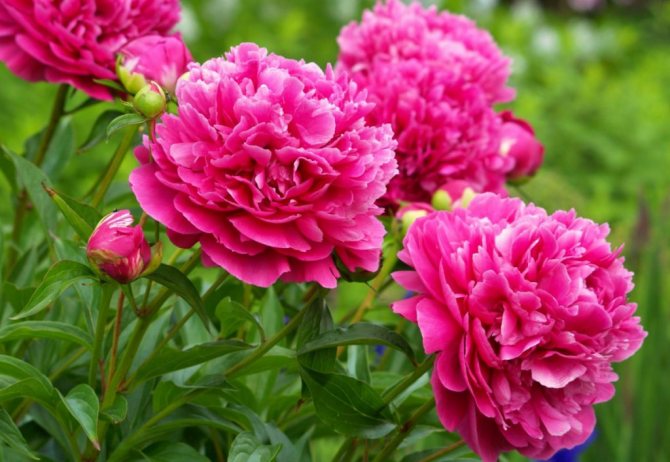

Snow Mountain. The height of the bush is up to 75 cm. The buds are cream-colored, 17 cm in diameter, the variety has strong stems. Leaves are dark green, shiny. Peduncles are strong, but they are inclined. Peony flowers of this variety have rounded petals. Average aroma. Resistant to adverse weather conditions, as well as diseases and pests; winter-hardy and drought-resistant. Cutting variety, in landscaping can only be used with a support. This is a versatile, one of the best varieties of peonies, it can be grown throughout Russia, except for the Far North.
Why does the shrub not bloom
Sometimes amateur gardeners are concerned about the lack of flowering of the tree peony. The reason for this may be both improper care and some other natural features.
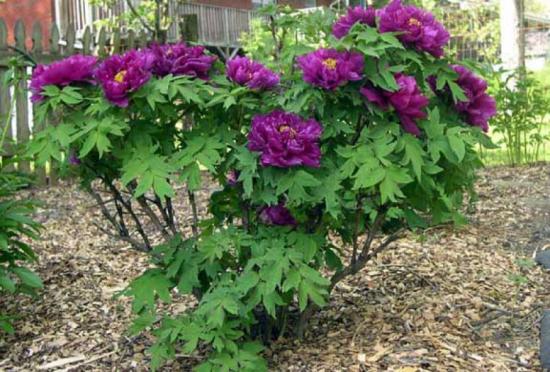

Most often, the lack of flowering is associated with the following factors:
- plant age. It may be either still too young or already too old;
- excessive deepening of the shrub during planting;
- abuse of nitrogen-containing fertilizers;
- compliance of the characteristics of the plant variety with the climatic features of the area;
- insufficient amount of sunlight;
- too close proximity to other plants;
- unsuccessful transplant;
- insufficient or excessive watering;
- incorrect cropping.
It is important to correctly determine the reason why the shrub does not bloom and quickly correct the wrong care.
Reproduction by layering
This should be done before the flowers bloom. Choose shoots that are closest to the ground. A cruciform incision is made on the shoot, treated with a growth stimulant and then bent close to the ground. It is best to secure the stem with an iron arc or press down with something. From above, part of the shoot with a cut must be sprinkled with soil. It is also necessary to constantly maintain moisture and water. In autumn - September - the rooted young peony is separated and transplanted to a permanent place.
Tree peony in the Moscow region: growing, planting and care
This plant is present in a single copy in my flower bed, but I would like to grow at least one more tree-like peony, only of a different variety. A place in the partial shade of the garden was just freed up, suitable for this elegant half-shrub. The decorative characteristics of such a peony are very high; it paints any corner of the summer cottage. In this article, we'll talk about how to grow, namely, plant and care for a tree peony in the Moscow region, what recommendations must be followed and what must be taken into account.
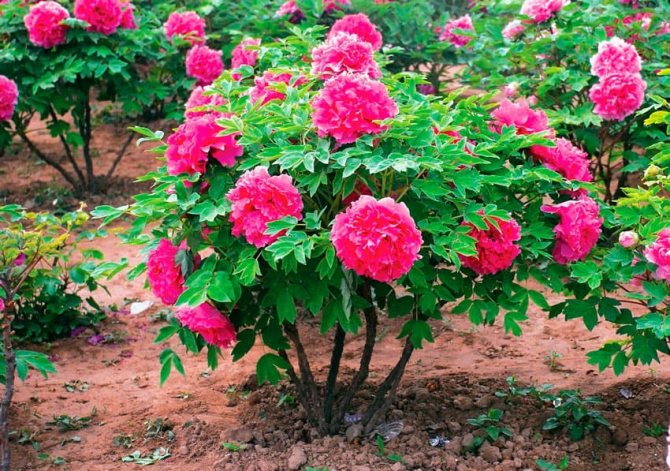

How to deal with dangerous pests and diseases
And there will be no struggle.
A huge plus of this species is that it practically does not undergo any plant diseases.
And pests are indifferent to him.
But since many other plants live in our garden, which are susceptible to various diseases, for the purpose of prophylaxis in the spring, you can treat our bush with fufanon and zircon.


Zircon is a stimulant of root formation and flowering.
How and where to plant a tree peony on the site?
When choosing this shrub for your garden, keep in mind that planting should be done only in late summer or autumn (until mid-September). When planting in spring, the probability of frost is very high, and this can adversely affect the plant: the buds or the whole peony will die. The place requires a bright, windless place. Strong winds can break branches near the bush. China is the country where the tree peony was first grown. The plant does not need shelter for the winter there. In our climate, this is necessary, therefore, when choosing a place, think in advance where there is more snow on the site. A cone-shaped hole for a peony is dug, crushed stone, brick chips, expanded clay, gravel are poured onto the bottom. Good humus is added to the earthen mixture, 200-300 grams of lime and superphosphate each. Planting must be done carefully, in no case should the growth point (root collar) be deepened. It is very easy to identify it in young plants; it has a larger diameter and resembles a cone. The soil must be well drained. The plant responds well to the introduction of ash or bone meal into the soil. It can be mixed with soil before planting. Can be diluted with water and occasionally watered peony. This is especially true if the soil is clayey, but you still really want to plant tree peonies.
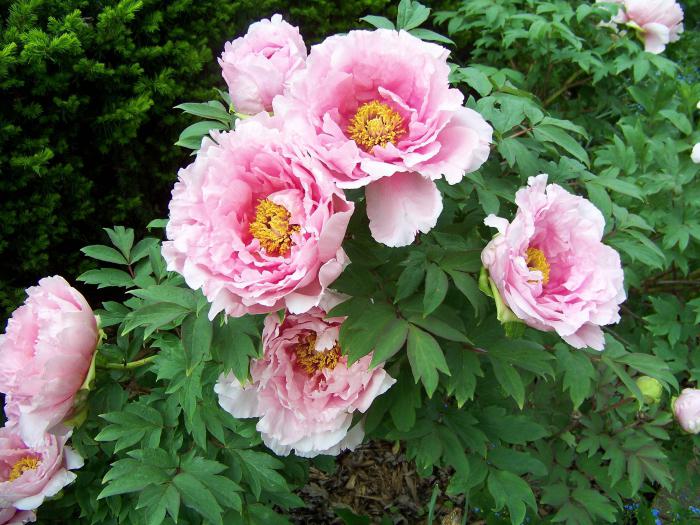

How to rejuvenate a plant
The rejuvenation of the tree peony is carried out by radical pruning .. The procedure is carried out after 10 years of the life of the plant ..
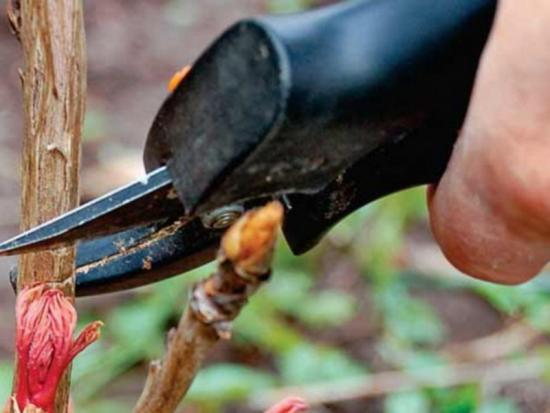

Cut the shoots at the root. The procedure promotes growth activation. If everything is done correctly, the flower will receive a powerful impetus for further development.
Tree peony - no worse than a rose
This shrub resembles a tree, its structure allows it to delight its owners with lush flowers for decades, and today there are enough varieties to choose according to their liking.Knowing all the rules of care, you can grow a real handsome man who is not inferior in beauty to a rose.
General information
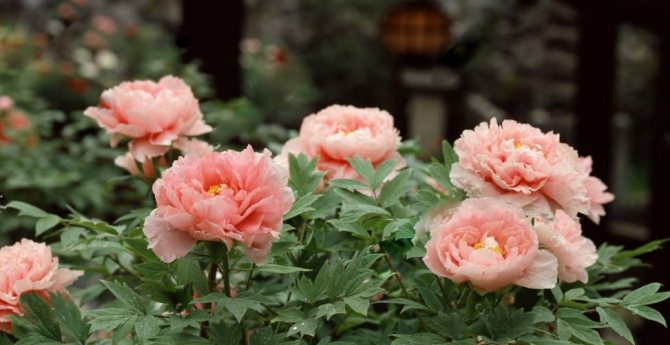

- Japan and China are considered the birthplace of the tree peony. However, today there are practically no wild thickets of this plant left. Naturally growing can only be found in southern Tibet or southwestern China at an altitude of 2400 m.
- The bush has differences in comparison with herbaceous plants: its height reaches one and a half meters with good care. There are specimens up to 2.5 m in height. The circumference of the plant is also rather big - about 1.5 - 1.7 m.
- The stems are lignified, dense and strong, every year they become thicker, in some, the diameter of the stem reaches almost 10 cm.
- The special charm and pride of the tree peony is its flowers, the circumference is up to 25 cm. The structure can be double, resembling a rose, semi-double and simple. Depending on the variety, the color range is very diverse: bright pink, white, delicate shades of lilac, fuchsia, blue and even green.
- The flowering period for this peony begins only at 4-6 years of life, blooms several weeks earlier than the bush peony, and the flowering itself lasts 14-20 days. At the same time, dark emerald leaves complement the beautiful flowers with delicate greenery.
The difference between tree peonies from ordinary peonies to prepare for the cold: in bush peonies, the aerial part dies off, and in tree peonies, foliage falls off.
Popular varieties
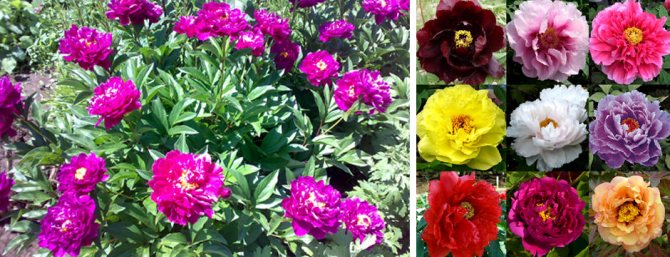

Let's name a few of the most famous varieties that can be planted in the Moscow region. All of them are very effective and are used in landscape design to decorate the backyard area. Peonies of this type are divided into 3 main groups:
- Chinese;
- bred varieties based on those brought from China;
- hybrids.
The work of breeders does not stop to this day. First, peonies were brought from China to Europe, they also grow in Japan, and lastly appeared in America. In Russia, they became known only in the 18th century, and firmly took a leadership position in floriculture. The following varieties have become widespread in the Moscow region.
- Green beans;
- Blue Moon;
- Flight of the swallow;
- August;
- Vesuvius;
- Spring Waltz;
- Torch;
- Coral;
- Kuindzhi and many others.
What is the difference between self-rooted and grafted peonies?
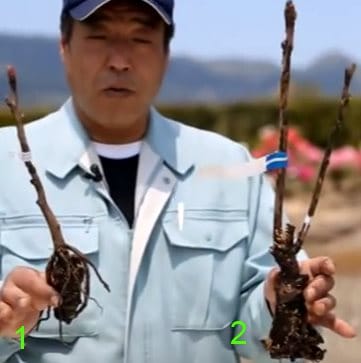

Dividing into 2 groups allows you to get flowering much earlier. Own-rooted plants live in one place for many years (there are specimens that are 400 years old) But their annual growth is very small, and the flowering period does not occur earlier than 4-6 years of life.
They are very well adapted for winter in the middle lane, easily reproduce by dividing the root. Resilient enough. Their root is represented by elongated light shoots 6 - 9 mm thick.
The grafted tree peonies cannot be propagated by dividing the rhizomes, but immediately need to be planted in a permanent place, since the transplant is extremely difficult to tolerate. The advantage is flowering for 1 - 3 years of life. They grow rapidly (20 - 40 cm per season). These peonies have a rhizome, similar to an analogue of an ordinary peony, is thicker and cylindrical in shape, 3 - 5 cm thick.
Experienced flower growers advise planting 2 types of such peonies: while the self-rooted one is slowly developing and growing, the grafted one already decorates with its beautiful flowering.
Reproduction by dividing the bush
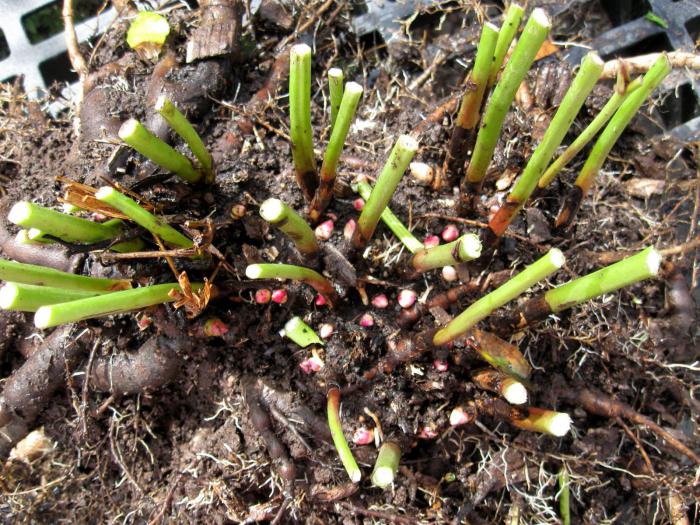

Held in mid or late August. Large and old specimens are dug up, the earth is washed off from the roots under a strong stream of water. Then the bush is divided, the process is similar to the reproduction of herbaceous peonies. You need to divide the roots with a sharp knife or ax, and root immediately to a permanent place. Thus, a young tree-like peony is obtained. Shelter for the winter is required the same as for adult specimens.
What is the difference between a tree peony and a herbaceous one
Hibiscus tree-like garden: care and cultivation
First of all, a tree-like peony can be distinguished from a herbaceous one by its stems.In the herbaceous variety, the shoots are soft, while in the tree peony they are tough, strong. This is due to the fact that in the fall the shrub sheds foliage, but not branches, which are only getting stronger every year. In a herbaceous peony, shoots die off every year.
Another difference is frost resistance. Varieties from China cannot boast of this quality, however, hybrids were bred in the botanical garden of Moscow State University, which can be grown not only in temperate climates, but also in the Urals and Siberia, which cannot be said about its herbaceous counterpart. At the first frost, its flowers quickly turn black.
The varieties also differ in ripening time. The herbaceous peony in the first years of life annually adds foliage in volume, but the flowering itself begins only at 3 years. The tree peony practically does not grow for the first 8-12 months. It may even seem that at some point the growth of the bush has stopped. The first flowers on the bush appear only when the plant reaches the mark of 50-60 cm.This usually happens 5 years after the planting of the peony.
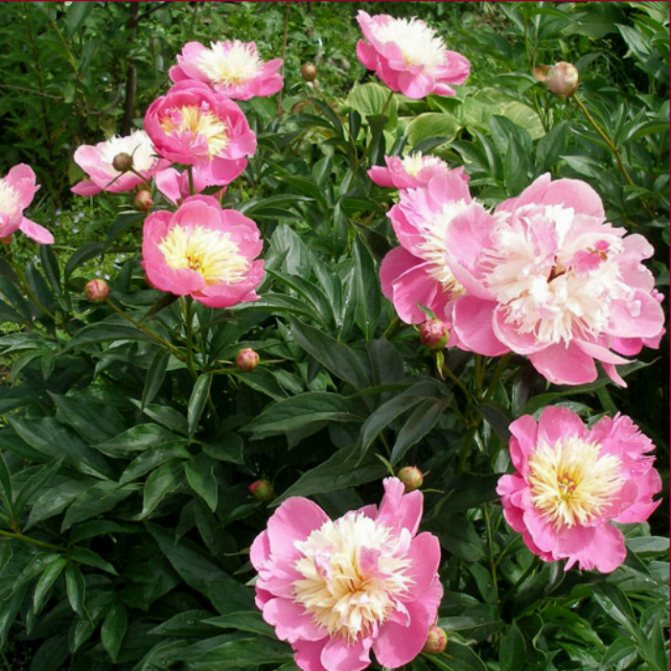

Herbaceous peony
In general, these two varieties bloom at different times. The herbaceous peony blooms 2 weeks later.
Finally, unlike the woody peony, the herbaceous cultivar needs to be pruned regularly. Cutting the buds stimulates subsequent flowering and helps to distribute the plant's vitality more efficiently.
How to grow a tree peony from seeds
Growing botanical species from seeds is an activity that requires a certain amount of patience. Unfortunately, the effectiveness of this method for a tree peony does not exceed 10%. However, if the grower has such a goal, it is worth giving it a try.
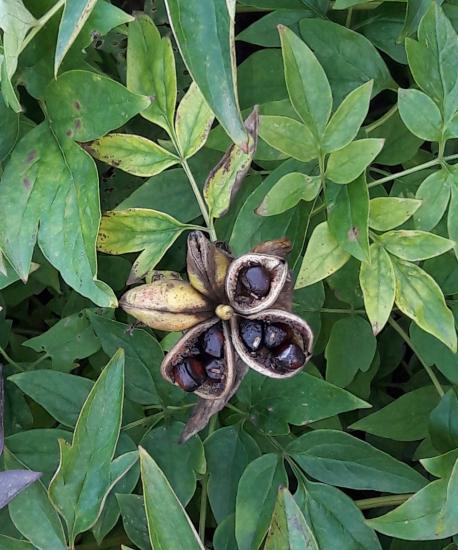

The easiest way is to plant the harvested ripe seeds directly into the ground. It will take about two years to wait for the result. During dry periods, the crop bed is watered.
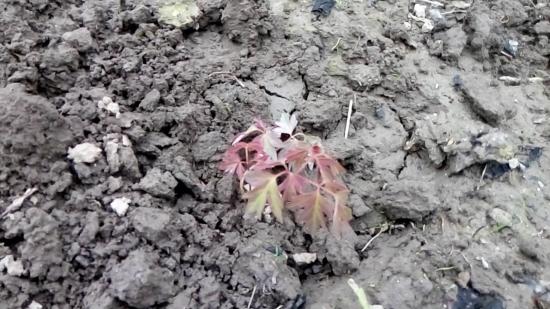

If everything goes well, shoots are expected to form in the second year. Individuals grown from seeds will begin to bloom in four years.
The most unusual varieties
Breeders have bred many varieties, each of which is highly decorative. Let's consider a few of them with the most bizarre coloration of large buds.
The Qiao sisters. A characteristic feature of the variety is an unusual combination of white and red shades in the color of the petals.
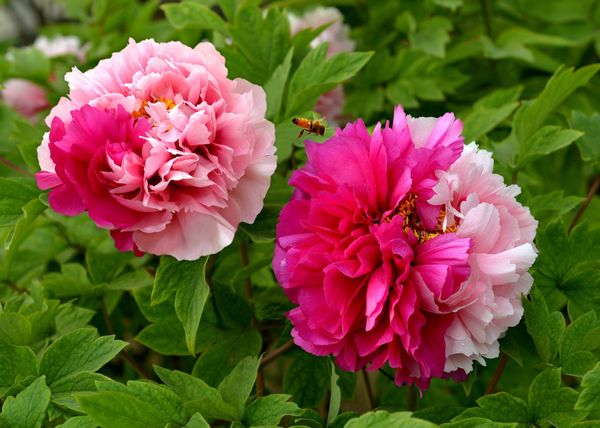

Primavera (primavera - spring in translation from Italian) is distinguished by a refined and delicate combination of pastel shades. The variety was created more than a century ago and is a bit like another spring flower - daffodil.
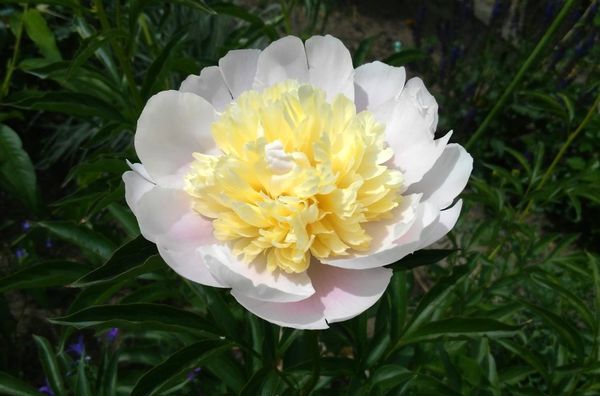

Silk veil is a variety with the most delicate white petals and a rich purple center.
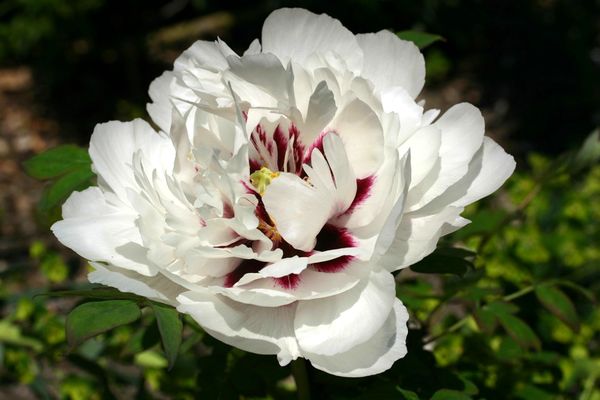

Tree peony: planting and care in the Moscow region, pruning after flowering
The tree peony, planting and caring for which is described in detail in our article, is very popular among gardeners due to its longevity and unpretentiousness. Consider how to independently propagate shrubs, and what conditions must be created for growing and abundant flowering of a crop.
The birthplace of the tree peony (lat.Paeonia suffruticosa) is China. In central Russia, gardeners are actively growing tree peonies, planting and caring for them does not cause any particular difficulties. And with the right choice of the variety and the observance of the rules of watering and feeding, you can enjoy magnificent flowering for a long time.
The most productive breeding
To obtain young plants for their site, without breeding purposes, vegetative methods are practiced:
- dividing the bush;
- vaccinations;
- grafting.
Seed reproduction is extremely difficult, only freshly ripe planting material emerges well. Waiting for seedlings is very long - 2-3 years.
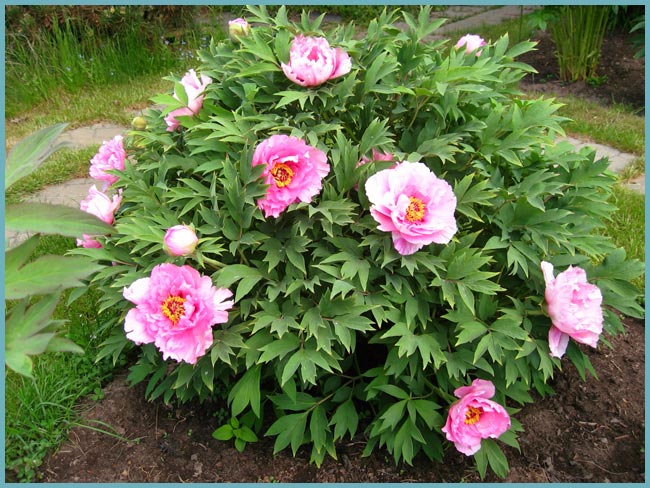

An adult bush can be propagated by dividing
The division of the bush is quite common, it can be divided at the age of at least 6 years. In August, the plant is dug up and carefully divided so that each division has buds (3-5) and roots.
Cuttings take root poorly, reproduction by this method is within the power of experienced growers, in special conditions. Treelike peony reproduces most successfully by grafting. You can graft in August, on the root system of herbaceous or tree-like forms. It is better to remove the leaves from the scion in order to reduce evaporation and moisture loss during the growing season. Grafts are planted with a bud deepening by 10 cm, this is important for the gradual formation of a healthy root system.
Although the flowering of the treelike peony lasts no more than 3 weeks, it is an impressive sight. Caring for this culture is quite common; it can live for a very long time, up to 100 years. Beautifully flowering highly decorative bushes will decorate any garden and become the pride of the owners.

